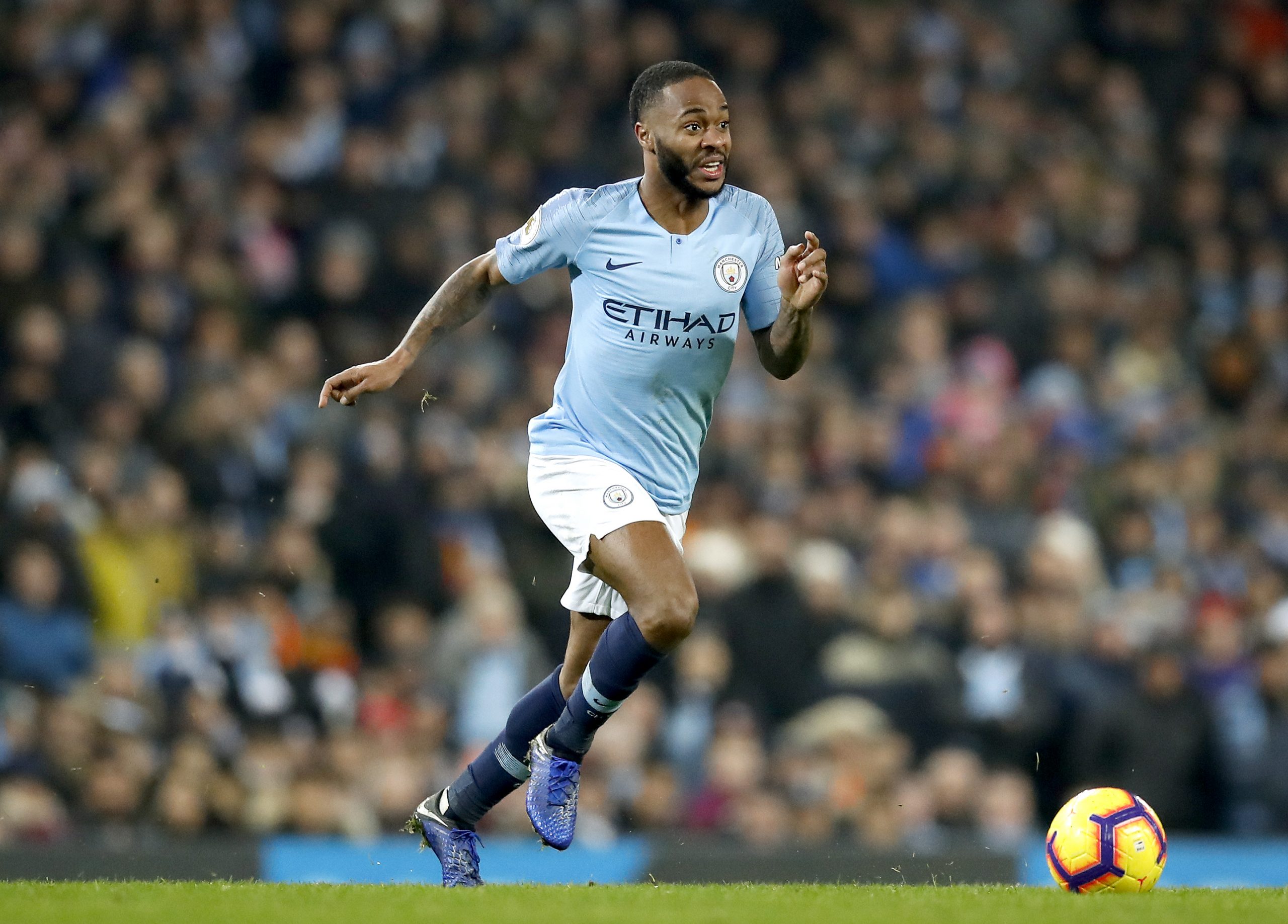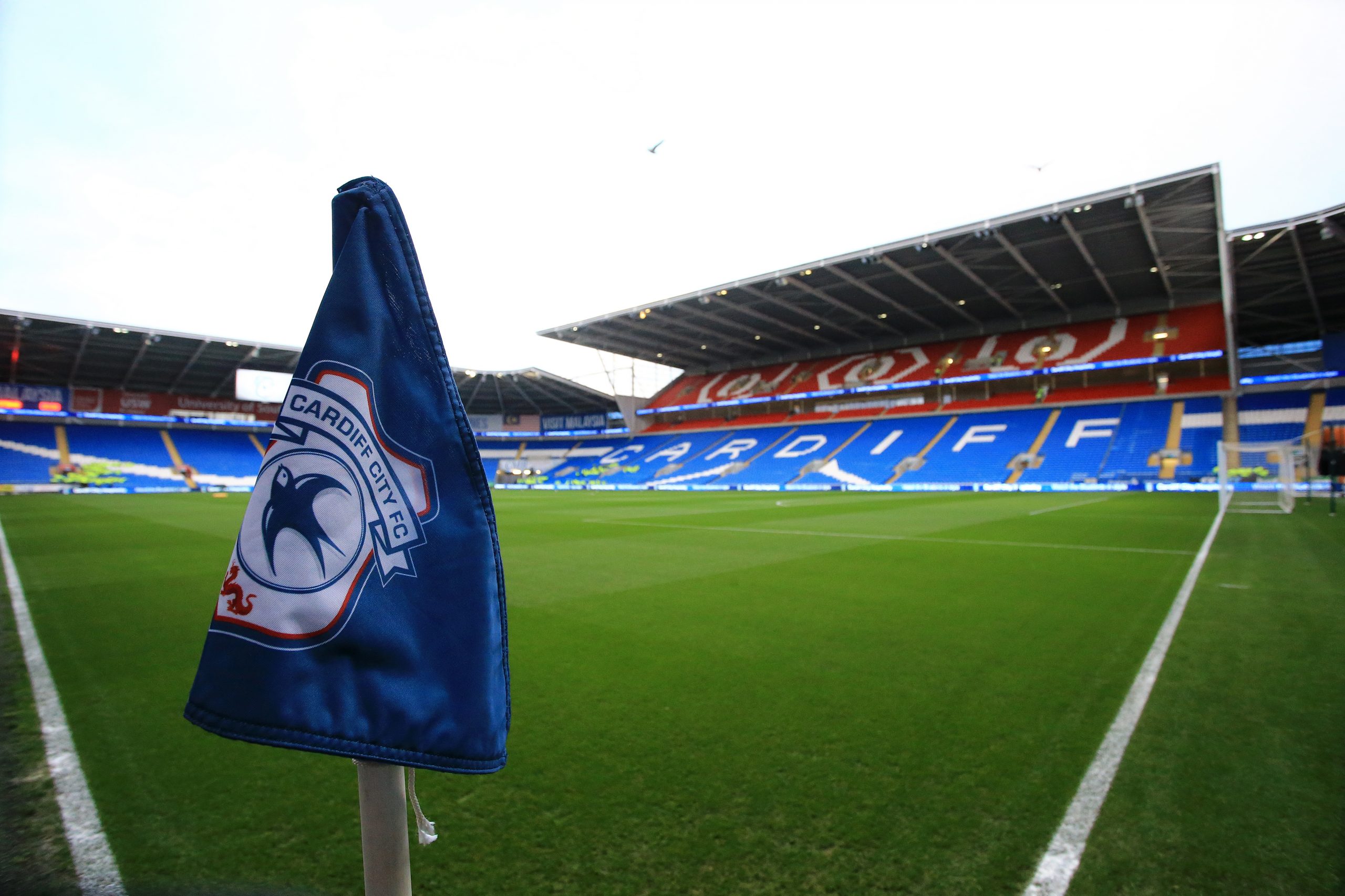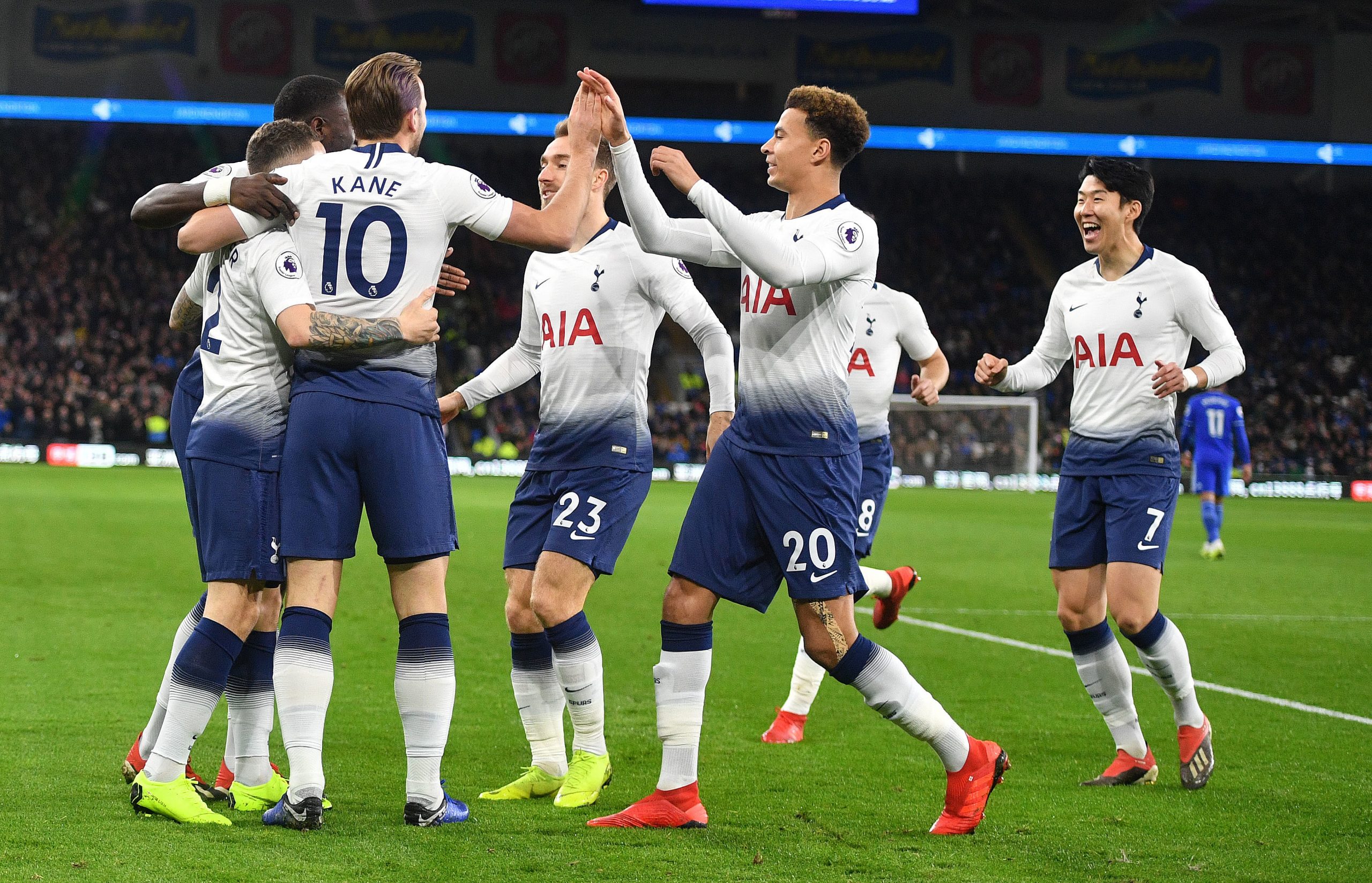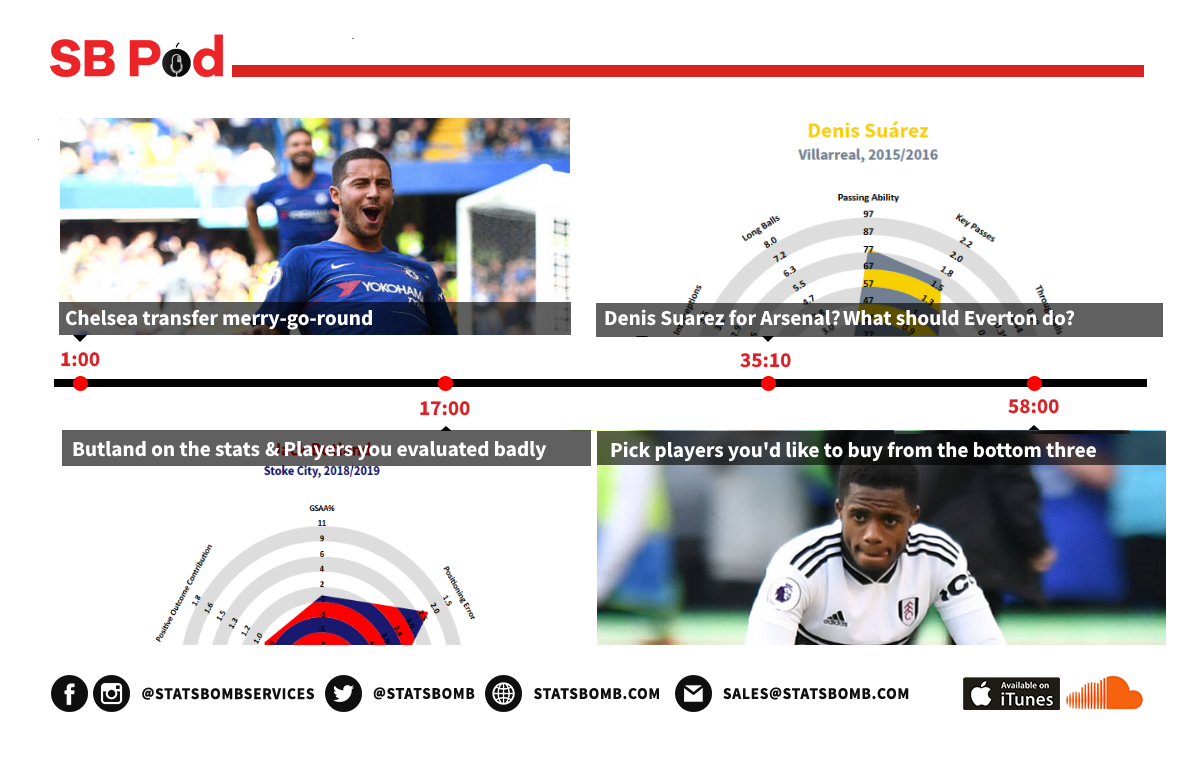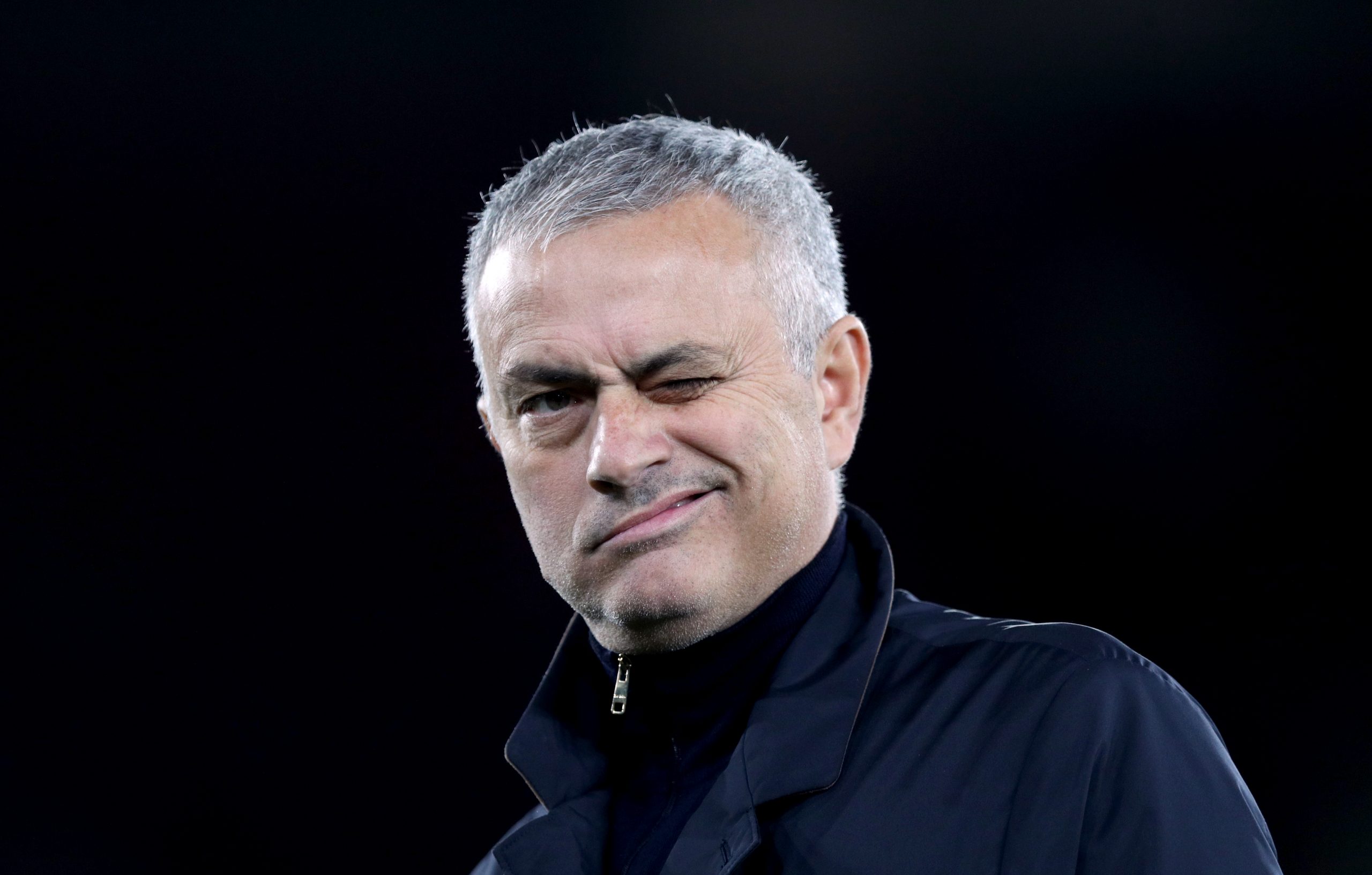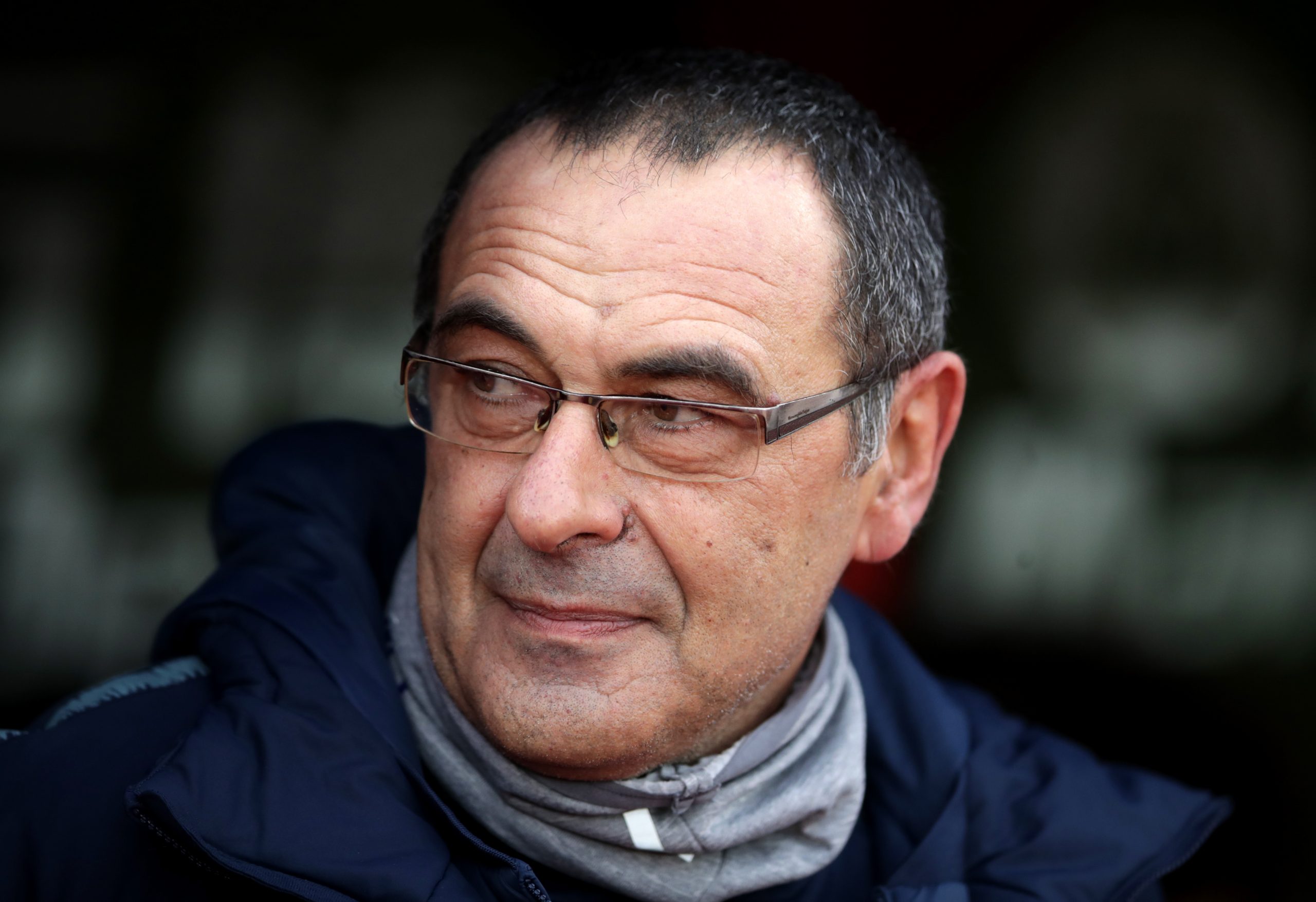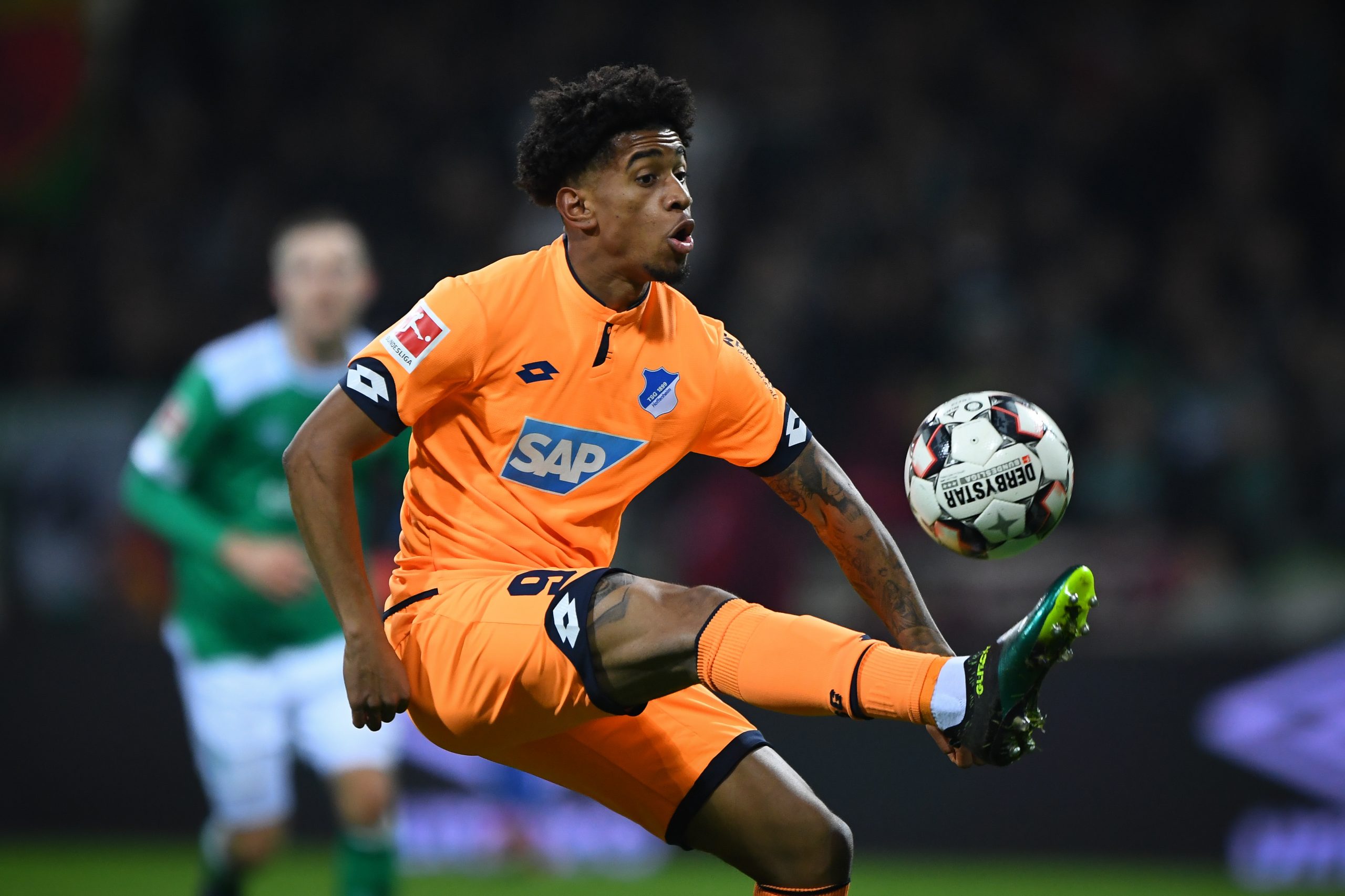What makes Fernandinho great? Everybody knows that Fernandinho is crucial to Manchester City’s success. And if they didn’t before, they certainly do after the last month. Manchester City’s two shock defeats to Crystal Palace and Leicester City coincided with the midfielders injury (now, like a good little stats monkey I shall remind you that correlation doesn’t equal causation etc etc and they should have won those games anyway, but also it was quite clear tactically they missed him desperately in midfield). The harder question is how did City become so reliant on a 33 year old playing a physically demanding position, and can they do anything to change it. Here’s what Fernandinho does. 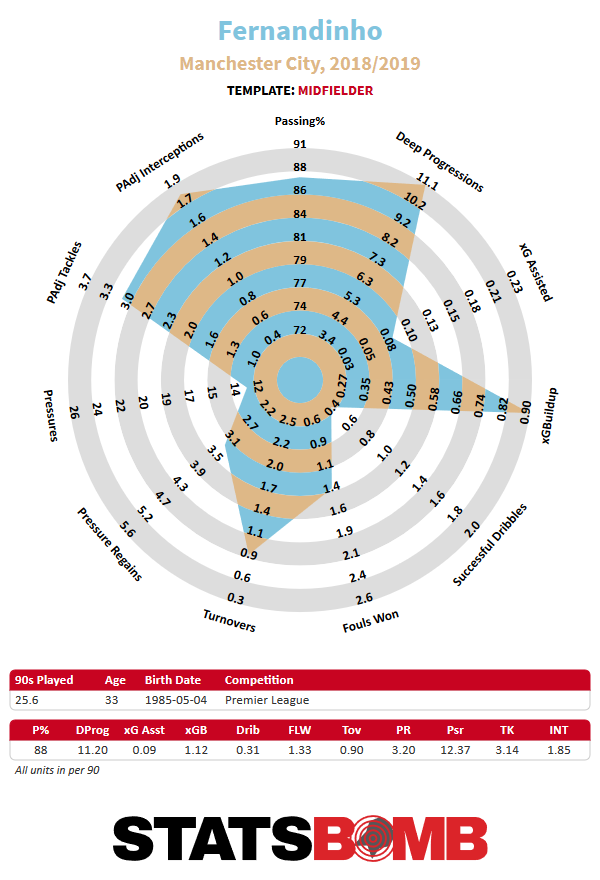 What makes him particularly unique is the way he combines both his attacking and defensive duties. On the defensive side of the ball, playing as the anchor of an elite pressing side he’s top 20 in the league in both possession adjusted tackles where he’s 12th in the league (among players with more than 800 minutes) with 3.06 and twelfth in the league in possession adjusted interceptions with 1.76. Though even that doesn’t quite tell the whole story. One of the most remarkable things about Manchester City’s press is how infrequently the team needs to clear the ball. The top of the possession adjusted clearances list is filled with defenders from teams that press high up the field. The top five are all from Liverpool, Arsenal and Tottenham. So are nine of the top twelve (with Adiran Mariappa of Watford and Michael Keane of Everton both of whom are high pressing squads making the list). Only Steve Cook of Bournemouth shows up as a center back clearing the ball while not obviously in an aggressive pressing system. But City’s center backs are nowhere to be seen. John Stones is 21st on the list and Aymeric Laporte is 26th. That’s not all down to Fernandinho of course, but he’s the lynchpin of a unique defensive system, one which not only presses opponents high up the field, but also one that allows center backs to recover the ball rather than clear it, and eases the burden on them so that they are really rarely called up as an emergency last line of defense. That’s what shielding a back line looks like. And this is how Fernandinho does it.
What makes him particularly unique is the way he combines both his attacking and defensive duties. On the defensive side of the ball, playing as the anchor of an elite pressing side he’s top 20 in the league in both possession adjusted tackles where he’s 12th in the league (among players with more than 800 minutes) with 3.06 and twelfth in the league in possession adjusted interceptions with 1.76. Though even that doesn’t quite tell the whole story. One of the most remarkable things about Manchester City’s press is how infrequently the team needs to clear the ball. The top of the possession adjusted clearances list is filled with defenders from teams that press high up the field. The top five are all from Liverpool, Arsenal and Tottenham. So are nine of the top twelve (with Adiran Mariappa of Watford and Michael Keane of Everton both of whom are high pressing squads making the list). Only Steve Cook of Bournemouth shows up as a center back clearing the ball while not obviously in an aggressive pressing system. But City’s center backs are nowhere to be seen. John Stones is 21st on the list and Aymeric Laporte is 26th. That’s not all down to Fernandinho of course, but he’s the lynchpin of a unique defensive system, one which not only presses opponents high up the field, but also one that allows center backs to recover the ball rather than clear it, and eases the burden on them so that they are really rarely called up as an emergency last line of defense. That’s what shielding a back line looks like. And this is how Fernandinho does it. 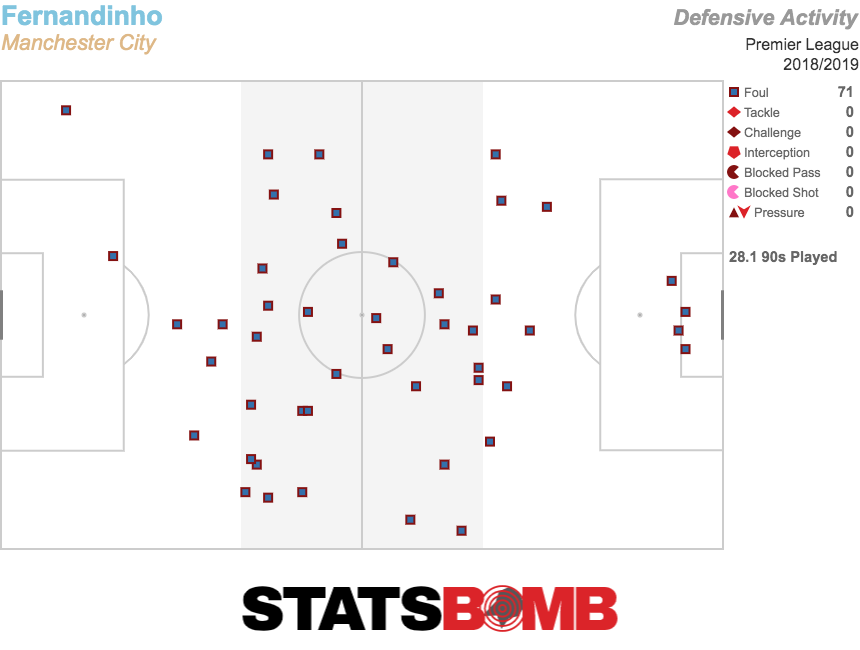 Fernandinho combines that activity at the base of midfield with an underrated ability to move the ball up the pitch. He’s fourth in the Premier League in deep progressions with 9.97 per 90 minutes. And again, that number doesn’t quite capture how unique his contribution is. While most deep lying players use longer passes to progress the ball, Fernandinho does not. There are only 10 players in the Premier League with over six deep progressions per game and under five unpressured long balls. Most of those players play much higher up the field than Fernandinho. Only Chelsea’s Jorginho, Liverpool’s Fabinho Fernandinho’s teammate Benjamin Mendy, Luke Shaw, Harry Winks and Aaron Creswell (sure why not?) play deeper positions. N’Golo Kante is also on this list though he is playing higher up the field as well. Putting it all together, Fernandinho is a player who relentlessly advances the ball into the final third while both not playing unpressured long passes and not leaving his defense exposed behind him. When looking at all the things Fernandinho does, very few players tick all those boxes. Combine the attacking side with possession adjusted tackles over two and possession adjusted interceptions over one and its only Kante, Fabinho, Jorgrinho, and Dele Alli who tick all of those statistical boxes. Alli plays higher up the pitch. Kante does too this season, although one can certainly imagine him doing everything Fernandinho does. Jorginho, just barely sneaks into this category on the defensive side of the ball. Given these numbers, it’s both easy to understand why City tried to acquire him last summer and also easy to suspect he wouldn’t have been up to the defensive responsibility. Then there’s Fabinho. He, out of everybody, comes closest to replicating the Fernandinho experience, although he does have the added benefit of spending most of his time in a double pivot with added midfied support. Looking abroad, the pickings are similarly slim. In Spain only 33 year old fullback Felipe Luis fits the bill. In Germany there are three. Mitchell Weiser, a 24 year old right back for Bayer Leverkusen, Leon Goretzka Bayern Munich’s big acquisition from last summer and perhaps most excitingly Florian Grillistch, Hoffenheim’s young 23 year old do it all midfielder.
Fernandinho combines that activity at the base of midfield with an underrated ability to move the ball up the pitch. He’s fourth in the Premier League in deep progressions with 9.97 per 90 minutes. And again, that number doesn’t quite capture how unique his contribution is. While most deep lying players use longer passes to progress the ball, Fernandinho does not. There are only 10 players in the Premier League with over six deep progressions per game and under five unpressured long balls. Most of those players play much higher up the field than Fernandinho. Only Chelsea’s Jorginho, Liverpool’s Fabinho Fernandinho’s teammate Benjamin Mendy, Luke Shaw, Harry Winks and Aaron Creswell (sure why not?) play deeper positions. N’Golo Kante is also on this list though he is playing higher up the field as well. Putting it all together, Fernandinho is a player who relentlessly advances the ball into the final third while both not playing unpressured long passes and not leaving his defense exposed behind him. When looking at all the things Fernandinho does, very few players tick all those boxes. Combine the attacking side with possession adjusted tackles over two and possession adjusted interceptions over one and its only Kante, Fabinho, Jorgrinho, and Dele Alli who tick all of those statistical boxes. Alli plays higher up the pitch. Kante does too this season, although one can certainly imagine him doing everything Fernandinho does. Jorginho, just barely sneaks into this category on the defensive side of the ball. Given these numbers, it’s both easy to understand why City tried to acquire him last summer and also easy to suspect he wouldn’t have been up to the defensive responsibility. Then there’s Fabinho. He, out of everybody, comes closest to replicating the Fernandinho experience, although he does have the added benefit of spending most of his time in a double pivot with added midfied support. Looking abroad, the pickings are similarly slim. In Spain only 33 year old fullback Felipe Luis fits the bill. In Germany there are three. Mitchell Weiser, a 24 year old right back for Bayer Leverkusen, Leon Goretzka Bayern Munich’s big acquisition from last summer and perhaps most excitingly Florian Grillistch, Hoffenheim’s young 23 year old do it all midfielder. 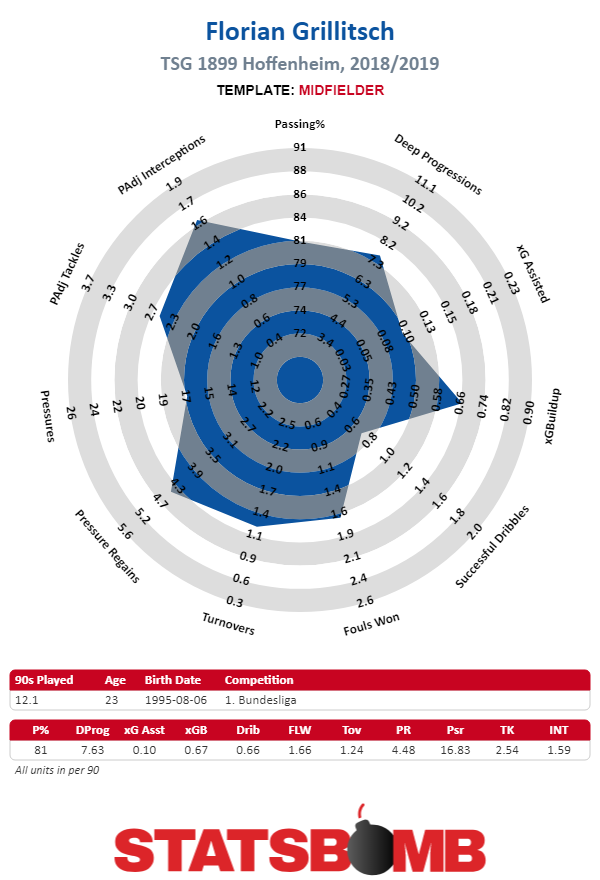 There are also only two players who have that collection of stats in Italy, and one of them already washed out once in England in AC Milan’s Tiemoué Bakayoko and he just barely clears the ball progression bar anyway. The other is Atalanta’s Remo Freuler. Who is, at the very least, intriguing.
There are also only two players who have that collection of stats in Italy, and one of them already washed out once in England in AC Milan’s Tiemoué Bakayoko and he just barely clears the ball progression bar anyway. The other is Atalanta’s Remo Freuler. Who is, at the very least, intriguing. 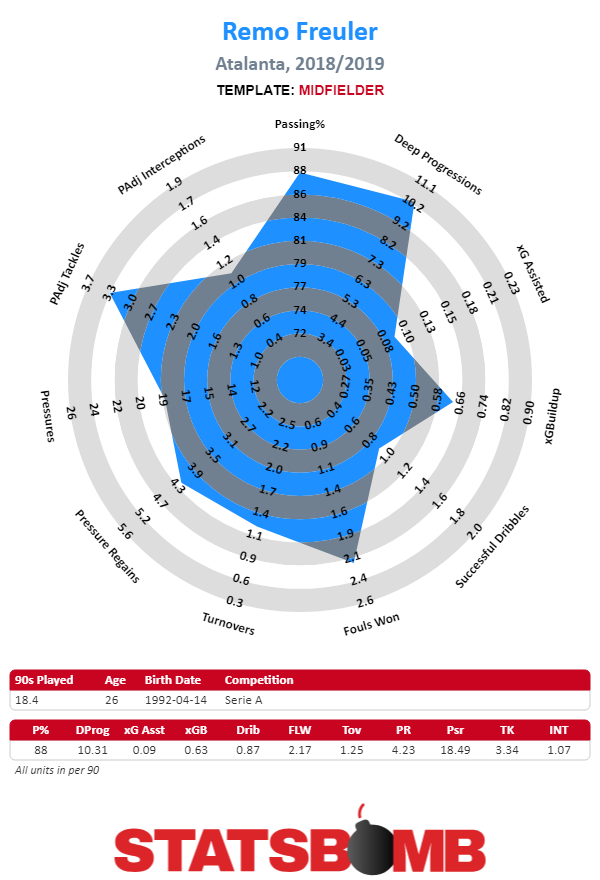 And finally in France there’s Marseille’s Bouna Sarr, who just barely does enough ball progression to crack the list (and is a fullback, sense a pattern here), everybody’s favorite midfield transfer target, Lyon’s Tanguy NDombele, currently rumored to be City’s first choice
And finally in France there’s Marseille’s Bouna Sarr, who just barely does enough ball progression to crack the list (and is a fullback, sense a pattern here), everybody’s favorite midfield transfer target, Lyon’s Tanguy NDombele, currently rumored to be City’s first choice 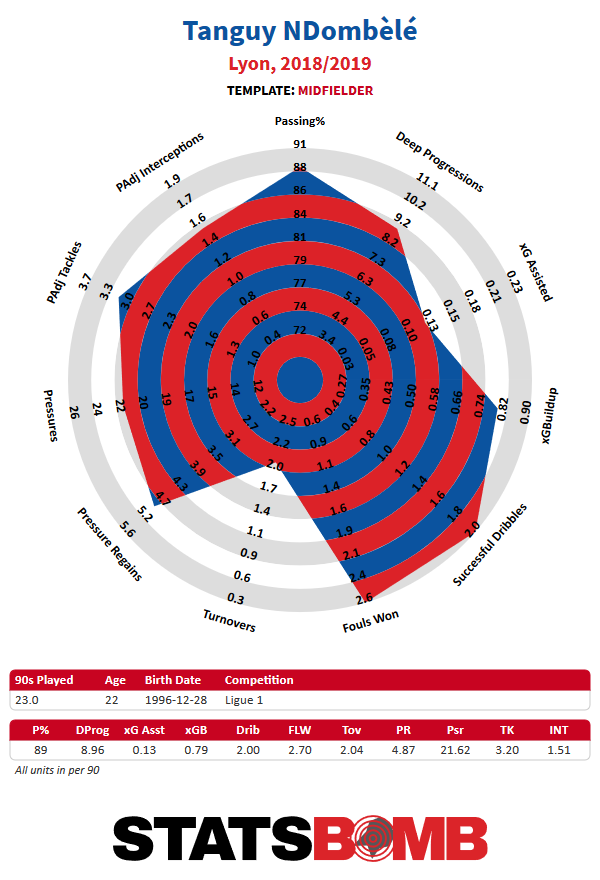 and also his 20(!) year-old teammate Houssem Aouar, who does just barely enough of everything to make the cut.
and also his 20(!) year-old teammate Houssem Aouar, who does just barely enough of everything to make the cut. 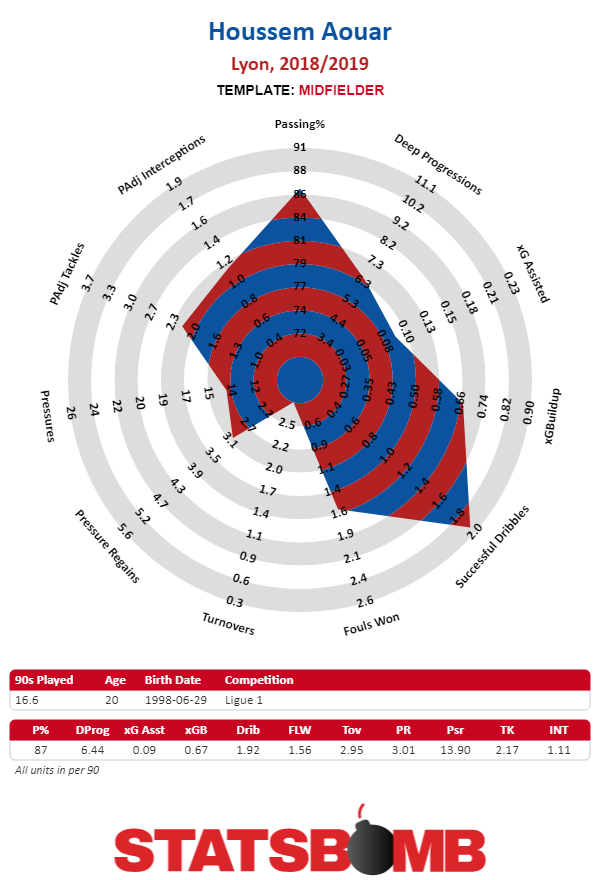 That quick tour around Europe shows a couple of things. First, there simply aren’t very many players that do what Pep Guardiola wants his deepest midfielder to do. Second, even the players who in theory do all those things, are not infrequently fullbacks, a fact which certainly fits with Guardiola’s career of merging the responsibilities of those two positions. Third, even the players who do do it all aren’t nearly as good at it as Fernandinho is. He is both an all around star, and elite at progressing the ball. That’s not to say there aren’t players who could possibly step up and fill Fernandinho’s shoes that aren’t on this list, but to do it effectively they’ll have to show a greater aptitude on one side of the ball or the other than they have to date. Guardiola demands an exceptionally broad range of skills from the player at the base of his midfield. They have to handle both defensive and attacking transition, defend in space, protect the back line and also bring the ball forward with their feet. Fernandinho does all that. The reason City have yet to develop a backup plan for him, is that very few other players in the world can compare.
That quick tour around Europe shows a couple of things. First, there simply aren’t very many players that do what Pep Guardiola wants his deepest midfielder to do. Second, even the players who in theory do all those things, are not infrequently fullbacks, a fact which certainly fits with Guardiola’s career of merging the responsibilities of those two positions. Third, even the players who do do it all aren’t nearly as good at it as Fernandinho is. He is both an all around star, and elite at progressing the ball. That’s not to say there aren’t players who could possibly step up and fill Fernandinho’s shoes that aren’t on this list, but to do it effectively they’ll have to show a greater aptitude on one side of the ball or the other than they have to date. Guardiola demands an exceptionally broad range of skills from the player at the base of his midfield. They have to handle both defensive and attacking transition, defend in space, protect the back line and also bring the ball forward with their feet. Fernandinho does all that. The reason City have yet to develop a backup plan for him, is that very few other players in the world can compare.
Month: January 2019
Raheem Sterling, Mohamed Salah and the Fight Against Easy Narratives
The current season is shaping up to be one that we’ll probably (hopefully) talk about for years to come, and Raheem Sterling and Mohamed Salah are two of the biggest reasons why. Thanks in large part to their star attackers, Manchester City and Liverpool are breezing through the year, breaking records like it’s their hobby. Despite that, people sitting on the sidelines have still, at times, wondered (sometimes with bonus racism!) whether or not the star players on either team are actually any good. Let’s start off by establishing some ground truths: Sterling and Salah are two exemplary players, and their clubs and the Premier League are lucky to have them. Sterling has an expected goal total of 0.33 per 90 minutes and an expected assist total of 0.39. Salah has one of 0.47 and 0.43. Moving out of the expected realm and into results, their scoring contributions per 90 (combining goals and assists) are 0.98 and 0.87 per 90, the third and sixth best total per 90 (of players with more than 800 minutes played). Sterling has continued his run of sublime shots this season, rarely taking a shot that isn’t on target. Look at this shot against Arsenal and Cech. With an xG of 0.05, Sterling dribbled the ball past seven players, shot past five of them, and caught Cech just that much out of position that it sailed home. He’s so good, City fans didn’t even realize the ball had gone in until Sterling began to celebrate. 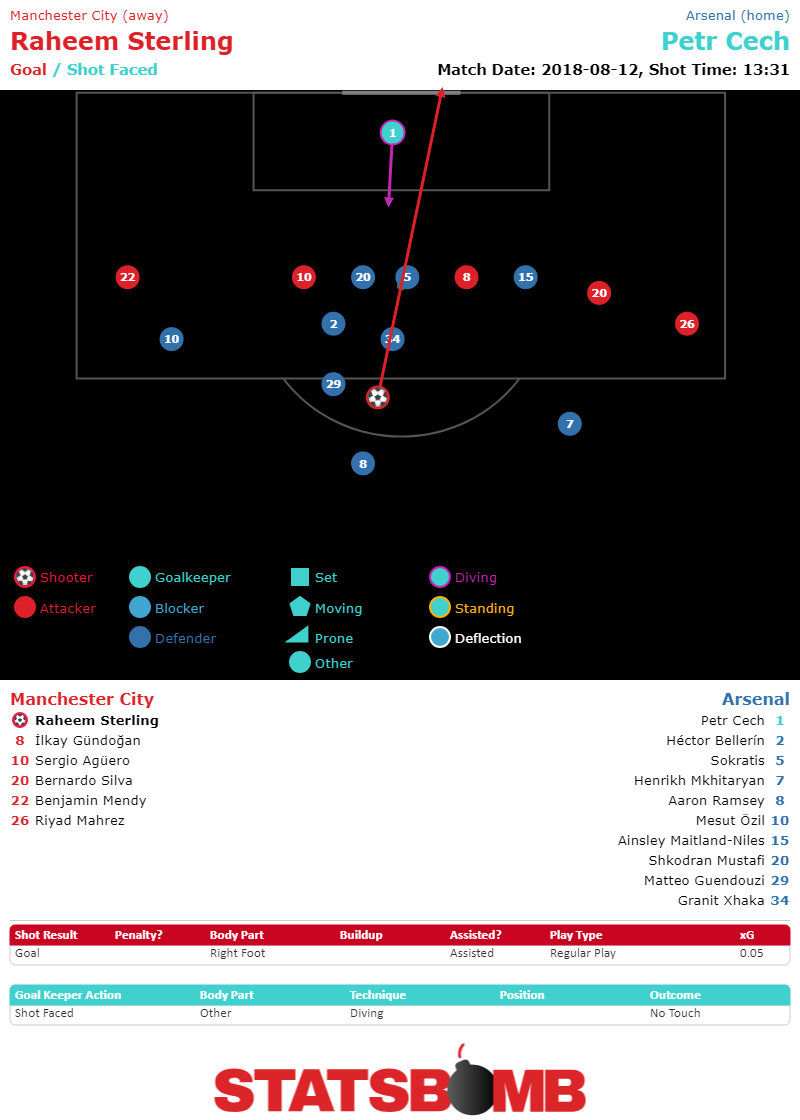 And even though this was at the start of the season and Sterling had ended the prior one spectacularly well, we were already hearing pundits pundit in tremulous tones about this mysterious affliction Sterling had where he just kept missing shots. The aforementioned affliction is, of course, all in their heads. But once a narrative takes hold it’s hard to shake. This season Sterling’s goal total of 9 is actually significantly above his xG of 5.73. He’s spent the season finishing the ball with aplomb. Here’s his shot distribution so far:
And even though this was at the start of the season and Sterling had ended the prior one spectacularly well, we were already hearing pundits pundit in tremulous tones about this mysterious affliction Sterling had where he just kept missing shots. The aforementioned affliction is, of course, all in their heads. But once a narrative takes hold it’s hard to shake. This season Sterling’s goal total of 9 is actually significantly above his xG of 5.73. He’s spent the season finishing the ball with aplomb. Here’s his shot distribution so far: 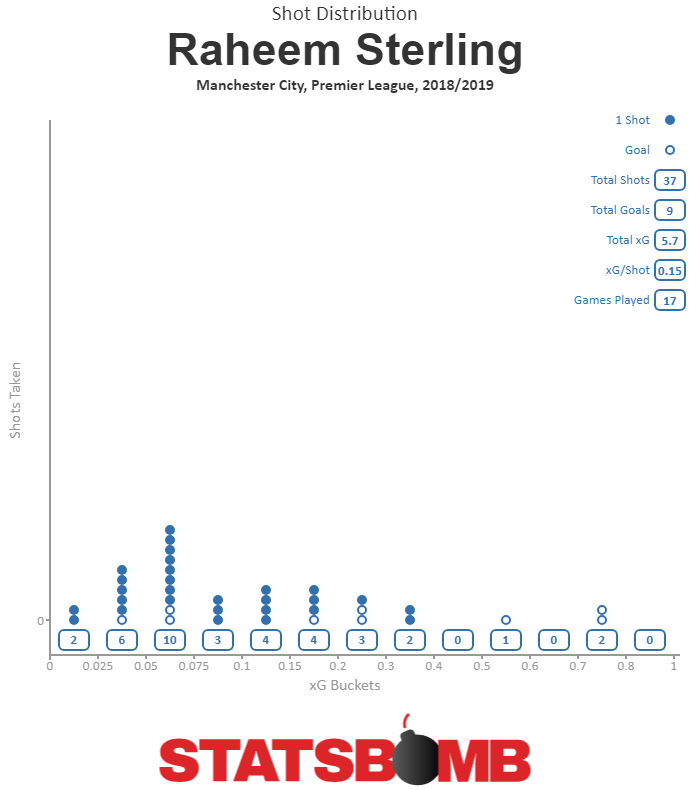 To paraphrase the immortal and musical Alexander Hamilton: Sterling very rarely throws away his shot. Particularly notable here are Sterling’s four goals from relatively low xG shots, opportunities where he’s maneuvered himself and the ball to catch the goalkeeper out of position. Here’s his spectacular strike against Newcastle, for example.
To paraphrase the immortal and musical Alexander Hamilton: Sterling very rarely throws away his shot. Particularly notable here are Sterling’s four goals from relatively low xG shots, opportunities where he’s maneuvered himself and the ball to catch the goalkeeper out of position. Here’s his spectacular strike against Newcastle, for example. 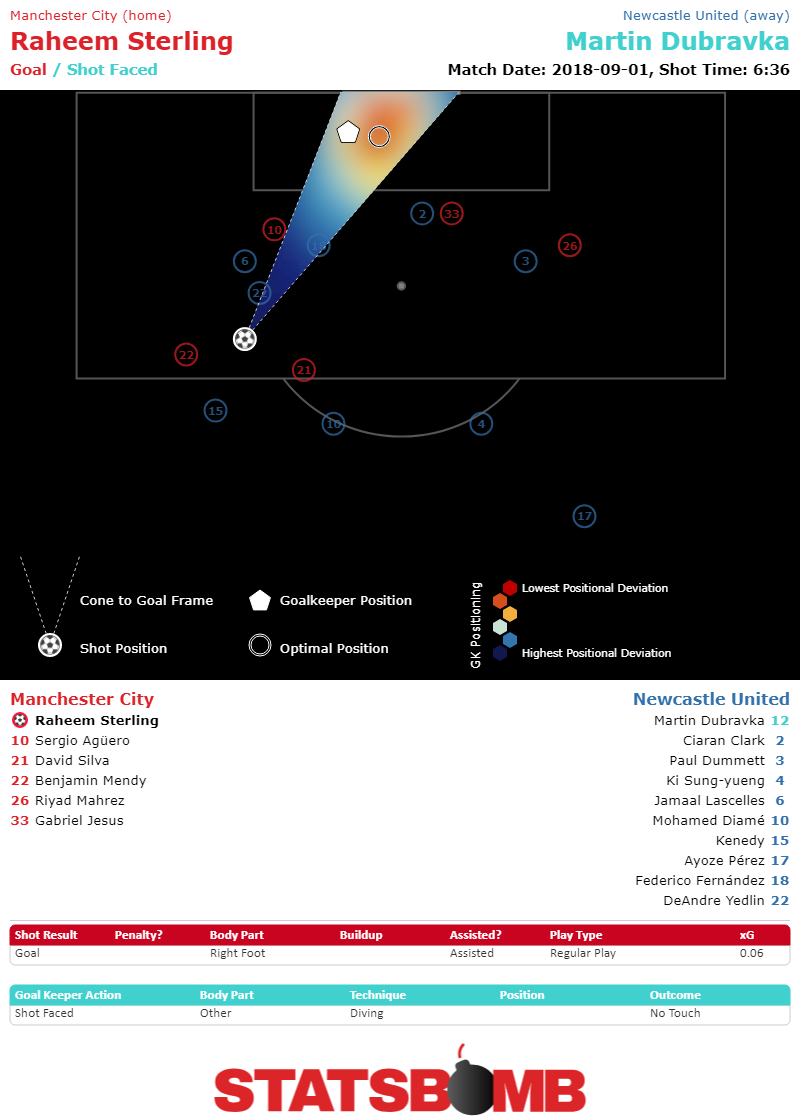 So if he’s only taking the most particular of shots, what’s he doing on the pitch for an entire game? The answer is: pretty much everything. Sterling is (still) an incredibly gifted player and playmaker. If anything, he’s elevated that part of his game.He’s beating more people off the dribble than he was last season, 2.72 vs 1.54, and his assists, key passes, throughballs, and passes into the box have all ticked higher. It’s probably statistically safe to conclude that he’s still a great player (insert joke about confidence intervals here).
So if he’s only taking the most particular of shots, what’s he doing on the pitch for an entire game? The answer is: pretty much everything. Sterling is (still) an incredibly gifted player and playmaker. If anything, he’s elevated that part of his game.He’s beating more people off the dribble than he was last season, 2.72 vs 1.54, and his assists, key passes, throughballs, and passes into the box have all ticked higher. It’s probably statistically safe to conclude that he’s still a great player (insert joke about confidence intervals here). 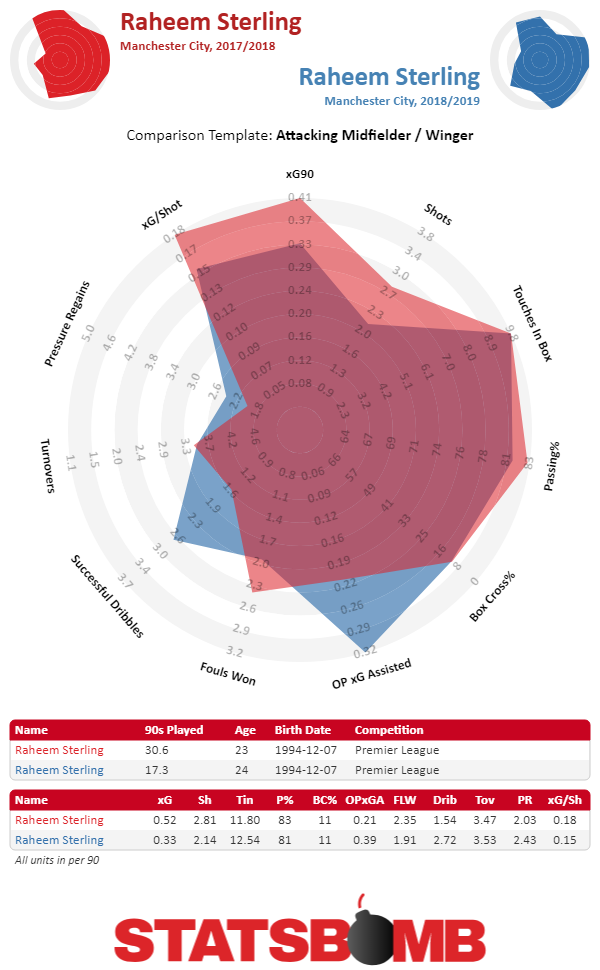 Sterling isn’t the only player that The Narrative has spent time wringing its hands over, though. Liverpool are good. They’re really good. But while it might already be lost to the sands of time, and a title race, the first stretch of the season featured a Salah goal drought for everyone to focus on, despite it being a completely manufactured issue. Salah’s xG/shot is slightly improved from last season, and much like Sterling, he’s netting more assists this season per 90 minutes. His finishing wasn’t exactly perfect at the start of the season, causing the goal scoring dip, but since his numbers remained strong it was definitely not enough that it should have caused any real worry.
Sterling isn’t the only player that The Narrative has spent time wringing its hands over, though. Liverpool are good. They’re really good. But while it might already be lost to the sands of time, and a title race, the first stretch of the season featured a Salah goal drought for everyone to focus on, despite it being a completely manufactured issue. Salah’s xG/shot is slightly improved from last season, and much like Sterling, he’s netting more assists this season per 90 minutes. His finishing wasn’t exactly perfect at the start of the season, causing the goal scoring dip, but since his numbers remained strong it was definitely not enough that it should have caused any real worry. 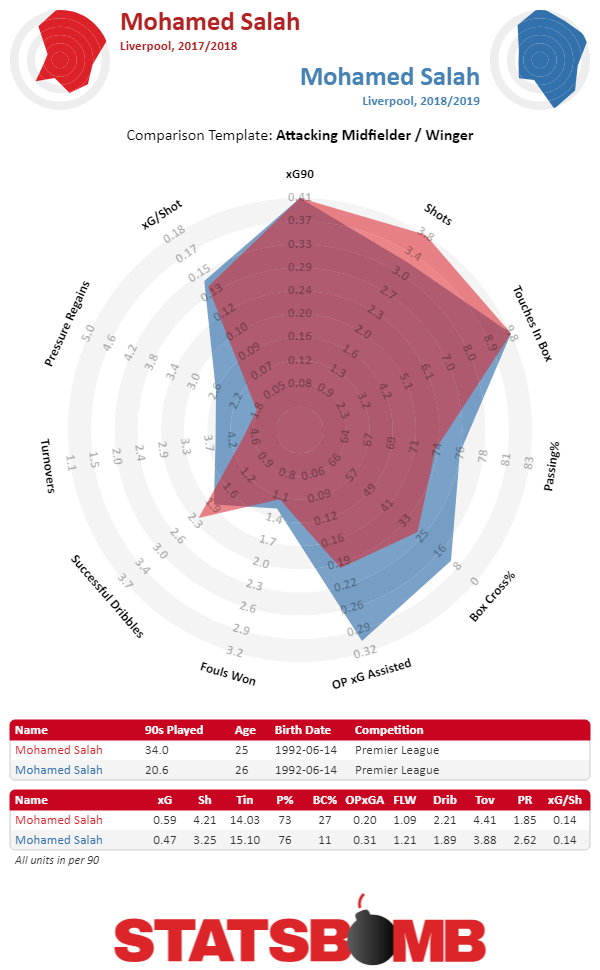 Of course, Salah is coming off a season where he just couldn’t stop scoring, and it makes some sense that everyone became more concerned about the shots he missed than how well he continued to play. It was a non-issue though, and sure enough Salah’s goals and assists this season have ended up just fine.
Of course, Salah is coming off a season where he just couldn’t stop scoring, and it makes some sense that everyone became more concerned about the shots he missed than how well he continued to play. It was a non-issue though, and sure enough Salah’s goals and assists this season have ended up just fine. 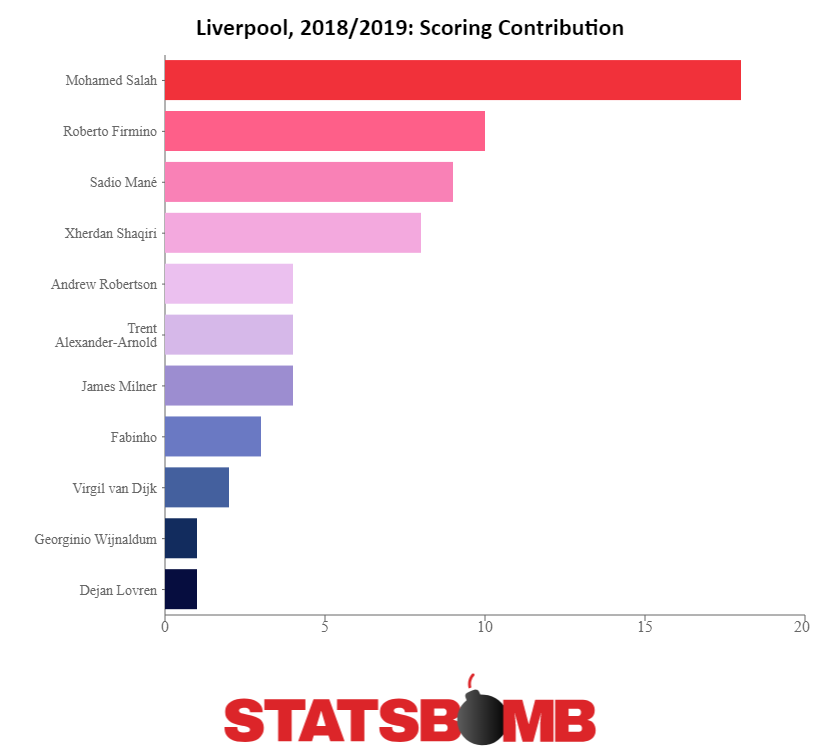 There’s no problem here, folks. This shouldn’t be the narrative you’re looking for. And that brings us to the other issue that can’t be avoided when discussing Sterling, Salah, and the constant doubt that surrounds them (Sterling more aggressively and with more vitriol than Salah): when you look at the numbers and then listen again to the questions being asked about them, it’s hard to think of a reason why the myths persist without asking some very difficult questions about The Narrative being spun and who benefits from it. We’ve spent a large part of December talking about how that narrative (and everything else about the media scrutiny around Sterling) is built to break down the best players, especially when they’re Black (for starters: see Sterling’s own writing on the topic). That’s good. The conversation on race and sports shouldn’t be a one-off thing that just comes up any time we have a particularly egregious incident. The other side of The Narrative is what we see with the coverage surrounding Salah: the ‘Egyptian King’ has been placed on a pedestal that’s rarely afforded to Muslim and foreign players, and the stories that surround him very often color him as the exception. The problem with this part of the narrative, of course, is that lauding someone for being exceptional despite their race or religion means their race and religion often becomes the focus when they do something wrong. The tweets about Salah’s soft penalty against Arsenal are pretty indicative of just how ugly that gets And we should also acknowledge what focusing on this narrative takes away from us (beyond it being dehumanising and terrible, of course): the ability to actually have legitimate conversations about the ways that both Sterling and Salah are excellent. There’s no avoiding the fact that both Sterling and Salah are in the news more often than not, and every single thing they do will be scrutinized, analysed, then repeated for a million years. We can, however, move the conversation beyond simply questioning whether or not they are actually good. Header Image Courtesy of the Press Association
There’s no problem here, folks. This shouldn’t be the narrative you’re looking for. And that brings us to the other issue that can’t be avoided when discussing Sterling, Salah, and the constant doubt that surrounds them (Sterling more aggressively and with more vitriol than Salah): when you look at the numbers and then listen again to the questions being asked about them, it’s hard to think of a reason why the myths persist without asking some very difficult questions about The Narrative being spun and who benefits from it. We’ve spent a large part of December talking about how that narrative (and everything else about the media scrutiny around Sterling) is built to break down the best players, especially when they’re Black (for starters: see Sterling’s own writing on the topic). That’s good. The conversation on race and sports shouldn’t be a one-off thing that just comes up any time we have a particularly egregious incident. The other side of The Narrative is what we see with the coverage surrounding Salah: the ‘Egyptian King’ has been placed on a pedestal that’s rarely afforded to Muslim and foreign players, and the stories that surround him very often color him as the exception. The problem with this part of the narrative, of course, is that lauding someone for being exceptional despite their race or religion means their race and religion often becomes the focus when they do something wrong. The tweets about Salah’s soft penalty against Arsenal are pretty indicative of just how ugly that gets And we should also acknowledge what focusing on this narrative takes away from us (beyond it being dehumanising and terrible, of course): the ability to actually have legitimate conversations about the ways that both Sterling and Salah are excellent. There’s no avoiding the fact that both Sterling and Salah are in the news more often than not, and every single thing they do will be scrutinized, analysed, then repeated for a million years. We can, however, move the conversation beyond simply questioning whether or not they are actually good. Header Image Courtesy of the Press Association
Cardiff's (Modest) Success Story
Why aren’t Cardiff terrible? Obviously, the team isn’t good. They currently sit in 17th place in the Premier League, only two points above the dreaded relegation zone. But, for a team that was the favorite to finish last before the season started, 17th place counts as unlikely achievement. How are they managing it? As always, the place to start is the numbers. Their underlying expected goals totals on both sides of the balls support their place in the table. Nobody will confuse Cardiff with a strong attacking team, but their 1.02 expected goals scored per 90 match is better than five other teams in the Premier League. Similarly, in defense, the 1.42 xG they concede per match to opponents is lower than five other teams. Put it all together and you have an xG difference of -0.41 (yay rounding) which places them above Fulham, Huddersfield Town, Burnley, Newcastle, and perhaps surprisingly, Brighton and Hove Albion. Their attack is a simple but effective one. They play the fewest passes per match, 315, of any side in England’s top flight. When they have the ball, they play fast, and they play direct. When Neil Etheridge restarts play in goal, he does it by launching the ball down the field. His kicks average over 64 yards, the longest of any keeper in the Premier League. Nobody in the league plays more unpressured long balls than Etheridge. Given that he’s played the longest passes, it’s unsurprising that Etheridge’s 36% pass completion rating is the lowest in the league. Many of the imbalances in Cardiff’s numbers stem from this tactical decision. The fact that they have so little of the ball is in large part because they are choosing to launch the ball upfield, happy to trade possession for territory. It’s not a revolutionary strategy. But, it is a strategy, and it’s one that Cardiff are executing effectively. Importantly, by playing extremely quickly and directly Cardiff are managing to keep their xG per shot numbers relatively respectable. At 0.09 xG per shot, Cardiff are 12th in the league. It’s nothing to write home about, but it’s just about good enough to make everything work even though the team only takes 11 shots, the fourth fewest, per match. They’re walking a precarious path, turning just enough long balls from goals into fast shots that are just good enough to be respectable. Combined that keeps their attack just above relegation level, but if either aspect slips they’ll be in trouble. Cardiff’s attack is simple but effective. It’s also basically the same way they approached the Championship. Although, in the Championship their superior physicality translated that approach into more success. They won more balls, took more shots, and in general converted more of their fast attacks into goals. But, while the attack has been consistent, if better than expected, it’s Cardiff’s defense that has been a surprise. Neil Warnock turned a defense that was basically a conservative deep block in the Championship into a much more active unit in the Premier League. As soon as the opposition enters Cardiff’s half they’re harried all over the pitch. 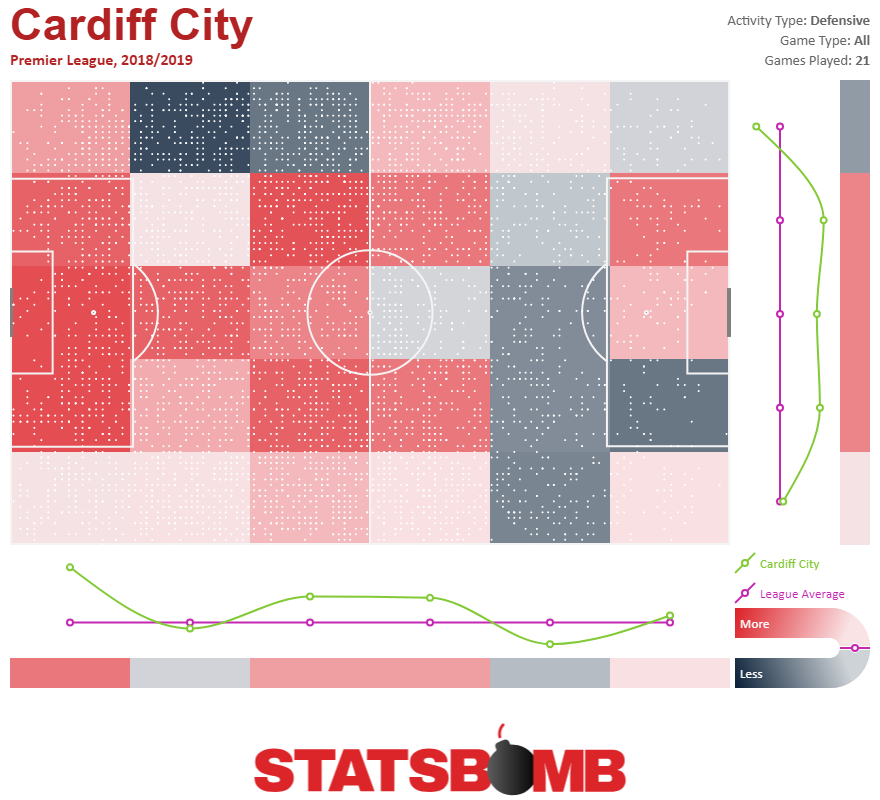 Bobby Reid (when he’s on the field) and Harry Arter in particular have been let lose to run around and bother the opposition. They are third and fourth in the Premier League respectively with 30.34 and 29.46 pressures per 90 minutes. Reid’s efforts are understandably focused centrally, he’s a forward after all. But it’s telling that his job is to actually pressure the ball as soon as it crosses the halfway line, not continue to drop back behind it as the team sags off.
Bobby Reid (when he’s on the field) and Harry Arter in particular have been let lose to run around and bother the opposition. They are third and fourth in the Premier League respectively with 30.34 and 29.46 pressures per 90 minutes. Reid’s efforts are understandably focused centrally, he’s a forward after all. But it’s telling that his job is to actually pressure the ball as soon as it crosses the halfway line, not continue to drop back behind it as the team sags off. 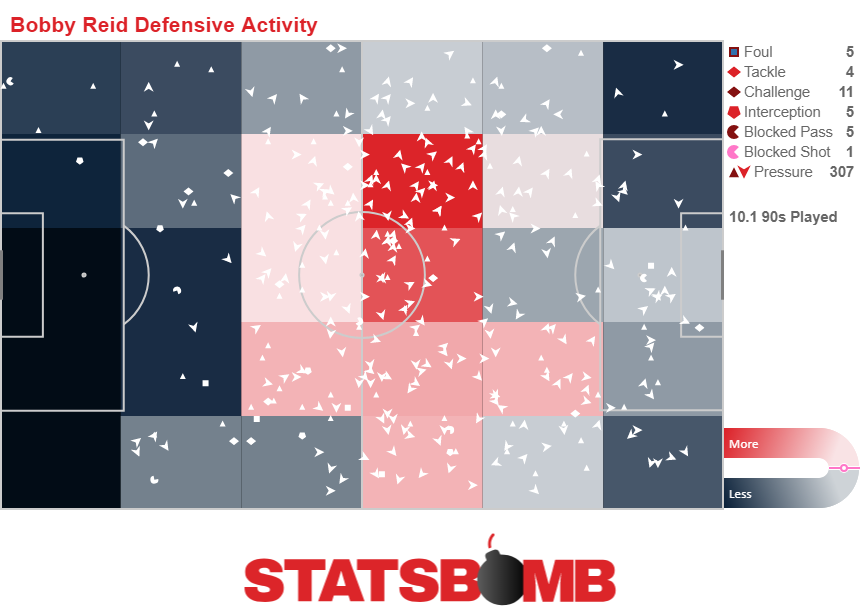 Arter, on the other hand, is a hound in midfield. He’s constantly challenging passers, obstructing passing lanes and generally making it a pain in the butt for teams to move the ball through him and break the lines.
Arter, on the other hand, is a hound in midfield. He’s constantly challenging passers, obstructing passing lanes and generally making it a pain in the butt for teams to move the ball through him and break the lines. 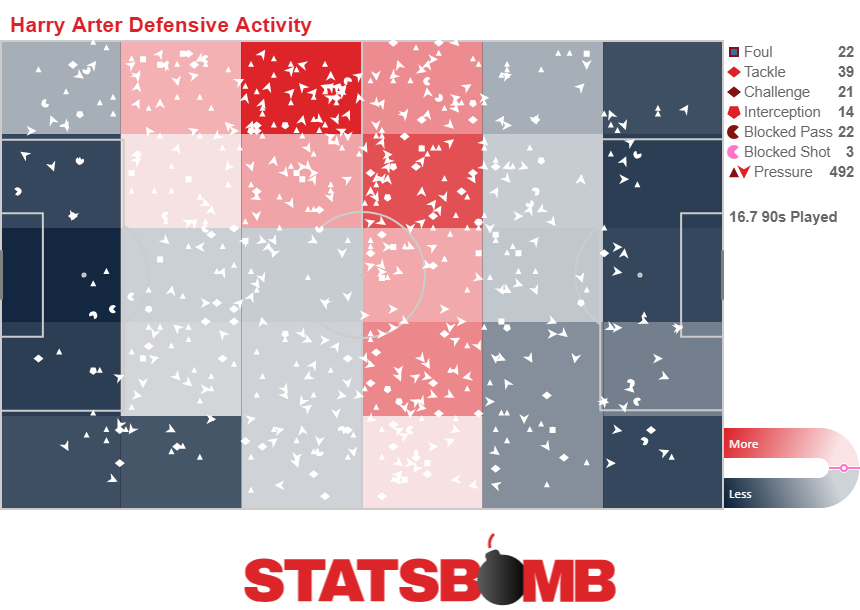 Arter, with Reid in front of him, makes it a real challenge for teams to attack through Cardiff’s center, and Warnock’s men can therefore force the ball to the wings where their defense is more than happy to deal with the crosses that come their way. Despite having very little of the ball, Cardiff is surprisingly effective at not being forced back deep into their own half. Their average defensive action comes 42.06 yards from their own goal. Nine teams, defend deeper than that. Their shots conceded number isn’t great, only three teams concede more than Cardiff’s 14.38, but given that they choose to have so little possession, it’s surprising it isn’t worse. On top of that seven teams give up a higher average xG per shot than Cardiff’s 0.10. Just like in attack Cardiff are treading that middle ground. They give up a lot of shots, but not so many that it kills them. The shots they give up are of below average danger, but not so innocuous that they have very much room to spare. They do just enough in both aspects to produce a defense that’s above relegation level, but not much above relegation level. Cardiff are unique. Usually teams that have very little of the ball do so because of the defensive choices they make. Sitting deep might increase their ability to stop opponents, but it makes it harder to keep possession when you get it. Having men behind the ball makes it harder to hit outlet passes, lets opponents pressure you and pin you in, and just in general slants the field against. But Cardiff’s low possession numbers hinge much more heavily on their attacking choices. They give the ball back a lot because they are maniacally committed to getting the ball up the field quickly at the expense of maintaining possession. What’s important, and what has been the key to their modicum of success, is that their defense then does the work of making sure the team doesn’t get pinned in. Rather than inviting teams onto their back line, and trying to hold the fort around their 18 yard box, Cardiff engage higher up in their own half. They have the freedom to attack directly because their midfield provides an effective shield to keep the ball from coming right back when they lose it. Warnock has instilled a plan in his team that, as of now, might see them through to an unlikely second consecutive season in the Premier League. Both in attack and in defense they’ve put the pieces together to generate just enough performance to keep them above the drop. If that continues over the second half of the season it will be a true accomplishment, and one that very few people saw coming.
Arter, with Reid in front of him, makes it a real challenge for teams to attack through Cardiff’s center, and Warnock’s men can therefore force the ball to the wings where their defense is more than happy to deal with the crosses that come their way. Despite having very little of the ball, Cardiff is surprisingly effective at not being forced back deep into their own half. Their average defensive action comes 42.06 yards from their own goal. Nine teams, defend deeper than that. Their shots conceded number isn’t great, only three teams concede more than Cardiff’s 14.38, but given that they choose to have so little possession, it’s surprising it isn’t worse. On top of that seven teams give up a higher average xG per shot than Cardiff’s 0.10. Just like in attack Cardiff are treading that middle ground. They give up a lot of shots, but not so many that it kills them. The shots they give up are of below average danger, but not so innocuous that they have very much room to spare. They do just enough in both aspects to produce a defense that’s above relegation level, but not much above relegation level. Cardiff are unique. Usually teams that have very little of the ball do so because of the defensive choices they make. Sitting deep might increase their ability to stop opponents, but it makes it harder to keep possession when you get it. Having men behind the ball makes it harder to hit outlet passes, lets opponents pressure you and pin you in, and just in general slants the field against. But Cardiff’s low possession numbers hinge much more heavily on their attacking choices. They give the ball back a lot because they are maniacally committed to getting the ball up the field quickly at the expense of maintaining possession. What’s important, and what has been the key to their modicum of success, is that their defense then does the work of making sure the team doesn’t get pinned in. Rather than inviting teams onto their back line, and trying to hold the fort around their 18 yard box, Cardiff engage higher up in their own half. They have the freedom to attack directly because their midfield provides an effective shield to keep the ball from coming right back when they lose it. Warnock has instilled a plan in his team that, as of now, might see them through to an unlikely second consecutive season in the Premier League. Both in attack and in defense they’ve put the pieces together to generate just enough performance to keep them above the drop. If that continues over the second half of the season it will be a true accomplishment, and one that very few people saw coming.
Tottenham's January Shopping List
This article was co-authored by @GraceOnFootball and @MoeSquare. No matter what the numbers have said this season, Spurs have just kept picking up wins. Their 48 points from 21 games so far is eight better than last season and the best the club have achieved at this stage since Mauricio Pochettino’s arrival. The curious thing, then, is that most of the statistical indicators tell us that Spurs have been kind of underwhelming. When looking at the expected goals trendlines, it becomes very clear that things are down notably from last season in both attack and defense. 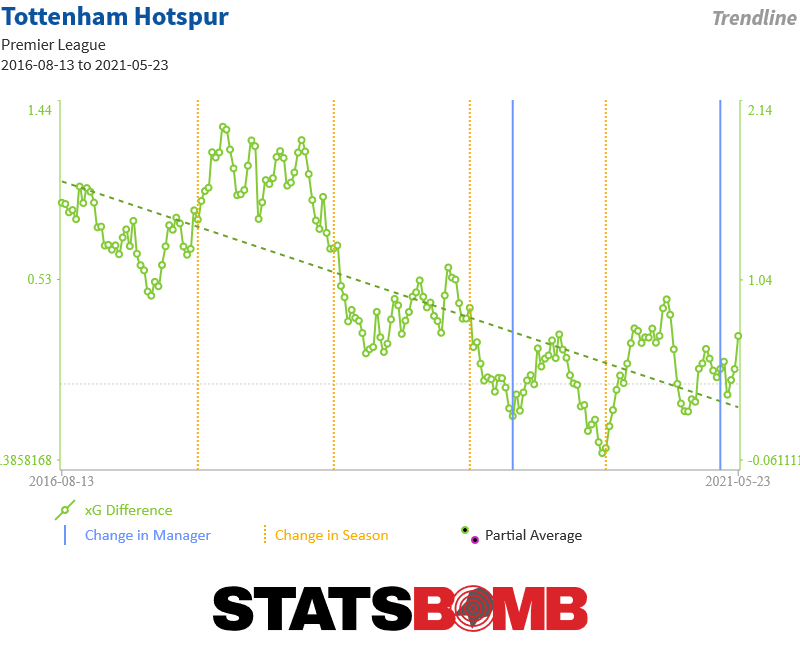 And yet the results keep coming. When looking at both shot maps below, we can see that Tottenham are really over-performing xG on the attacking side (left), while seeing a slight beating of expectations on the defensive end (right).
And yet the results keep coming. When looking at both shot maps below, we can see that Tottenham are really over-performing xG on the attacking side (left), while seeing a slight beating of expectations on the defensive end (right). 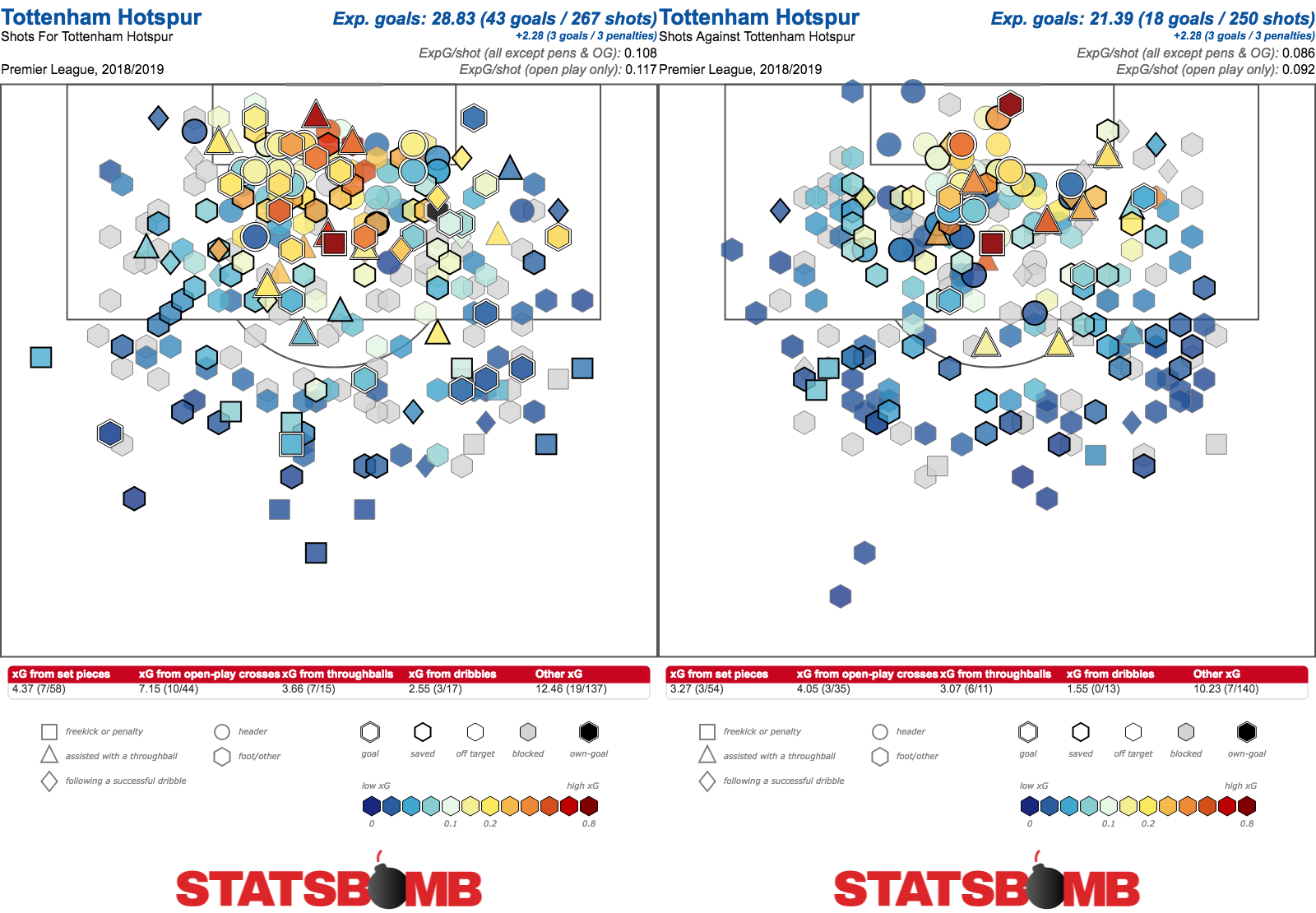 The extent to which this is repeatable remains an open question. The evidence we have suggests Pochettino’s Spurs have a habit of beating the metrics, so there may be something here. What has never been clear, though, is whether Tottenham’s overperformance in past years has been down to tactical choices or simply the combination of above average finishers (particularly Harry Kane and Son Heung-min, while Dele Alli has had good finishing runs at times) matched with Hugo Lloris’ excellent goalkeeping. What does seem apparent, though, is that Spurs do not generally beat xG to the extent that they are right now. When looking at last season’s data, they only overperformed on the attacking side by 12% in 2017/18, whereas right now they are doing so by 49%. That’s a lot. So have Spurs at least made tactical changes that might account for some of the difference? Quite possibly. As Michael Caley’s research has shown, Tottenham place a much greater emphasis than other top six sides this season on attacking from very short moves. Similarly, StatsBomb’s data have Spurs second in the league for counter attacking shots (taken within 15 seconds of a possession that originates in the opposition’s own half), behind only Leicester and ahead of all other top six clubs. Tottenham are certainly doing things differently this year, though it’s still hard not to feel as though they have had the rub of the green in terms of finishing. Tactically, the big shift in the last few months has been toward the diamond system. Harry Winks has been the deepest midfielder (though Eric Dier had also played this role before his current injury), with Christian Eriksen and Moussa Sissoko in shuttling roles slightly advanced of him and Alli playing as the number ten behind two strikers, usually Son and Kane. Alli in particular seems to be thriving in this role, giving him the licence to find space with his intelligent movement. The 3-1 victory over Chelsea, in which he nullified Jorginho while contributing a goal and an assist, remains a highlight. Meanwhile, Pochettino has finally found use for Sissoko’s fairly limited skillset in a shuttler role getting up and down the pitch. On the other hand, Eriksen has had to become a much more active defender in this midfield role. While that is certainly something he is capable of, the more attacking positions he took up in previous years allowed him to be a better involved playmaker along with scoring and assisting more often. Eriksen certainly hasn’t been bad this season, far from it, but when comparing his radars to last season it does feel as though a chunk of his game has been sacrificed on the attacking side.
The extent to which this is repeatable remains an open question. The evidence we have suggests Pochettino’s Spurs have a habit of beating the metrics, so there may be something here. What has never been clear, though, is whether Tottenham’s overperformance in past years has been down to tactical choices or simply the combination of above average finishers (particularly Harry Kane and Son Heung-min, while Dele Alli has had good finishing runs at times) matched with Hugo Lloris’ excellent goalkeeping. What does seem apparent, though, is that Spurs do not generally beat xG to the extent that they are right now. When looking at last season’s data, they only overperformed on the attacking side by 12% in 2017/18, whereas right now they are doing so by 49%. That’s a lot. So have Spurs at least made tactical changes that might account for some of the difference? Quite possibly. As Michael Caley’s research has shown, Tottenham place a much greater emphasis than other top six sides this season on attacking from very short moves. Similarly, StatsBomb’s data have Spurs second in the league for counter attacking shots (taken within 15 seconds of a possession that originates in the opposition’s own half), behind only Leicester and ahead of all other top six clubs. Tottenham are certainly doing things differently this year, though it’s still hard not to feel as though they have had the rub of the green in terms of finishing. Tactically, the big shift in the last few months has been toward the diamond system. Harry Winks has been the deepest midfielder (though Eric Dier had also played this role before his current injury), with Christian Eriksen and Moussa Sissoko in shuttling roles slightly advanced of him and Alli playing as the number ten behind two strikers, usually Son and Kane. Alli in particular seems to be thriving in this role, giving him the licence to find space with his intelligent movement. The 3-1 victory over Chelsea, in which he nullified Jorginho while contributing a goal and an assist, remains a highlight. Meanwhile, Pochettino has finally found use for Sissoko’s fairly limited skillset in a shuttler role getting up and down the pitch. On the other hand, Eriksen has had to become a much more active defender in this midfield role. While that is certainly something he is capable of, the more attacking positions he took up in previous years allowed him to be a better involved playmaker along with scoring and assisting more often. Eriksen certainly hasn’t been bad this season, far from it, but when comparing his radars to last season it does feel as though a chunk of his game has been sacrificed on the attacking side. 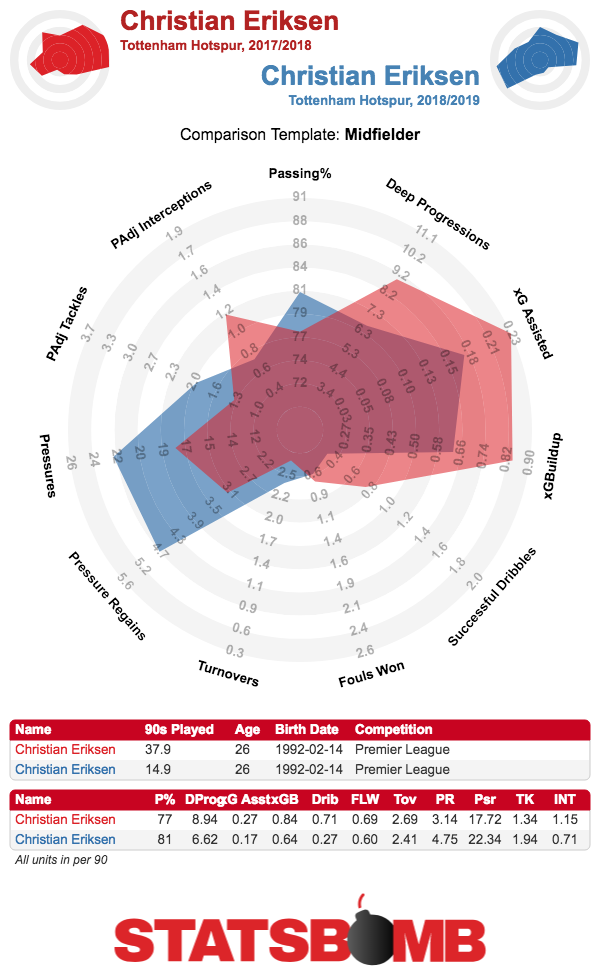 Winks has found himself with a similar problem. Though he remains a decent distributor, his ball progression abilities are significantly constrained as he sits in front of the back four. As the season has gone on, his defensive pressure numbers have gradually risen while his deep progressions and other numbers have fallen. When comparing this season to last, it’s obvious that Spurs are using him differently, but not necessarily more effectively.
Winks has found himself with a similar problem. Though he remains a decent distributor, his ball progression abilities are significantly constrained as he sits in front of the back four. As the season has gone on, his defensive pressure numbers have gradually risen while his deep progressions and other numbers have fallen. When comparing this season to last, it’s obvious that Spurs are using him differently, but not necessarily more effectively. 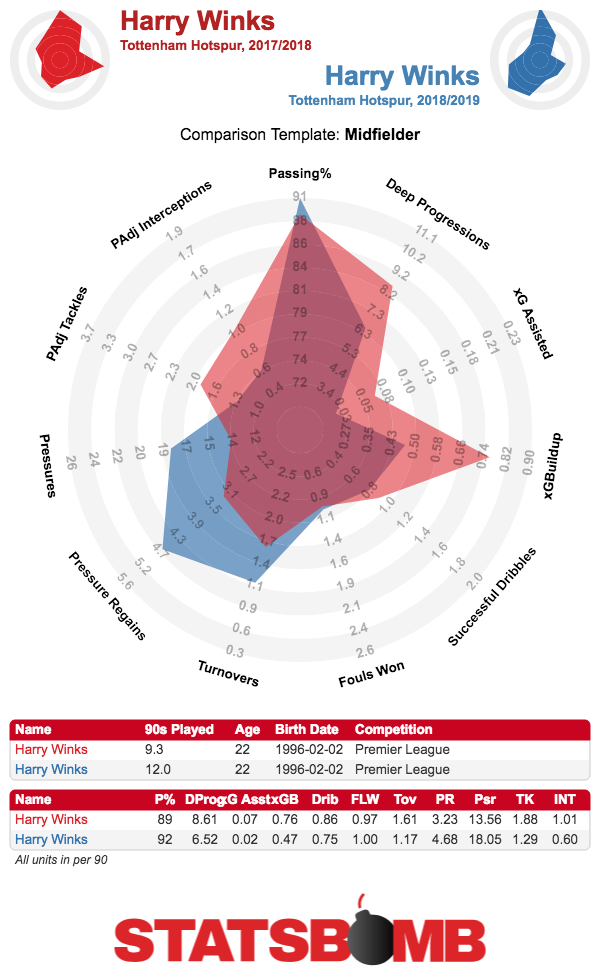 That so much has been shuffled around in midfield is quite obviously an attempt from Pochettino to mitigate the issue that they didn’t buy anyone there. In the 2015-16 season, Spurs could rely on the partnership of Dier and Mousa Dembele, with Dier offering a solid job as a holding player relying on positional sense while Dembele was a genuine unicorn of a player, combining a great defensive work rate with a unique ability to move the ball through midfield and evade pressure. In the summer of 2016, the club added Victor Wanyama, a destructive defensive midfielder who gave Tottenham excellent midfield depth. Fast forward to 2019 and both Wanyama and Dembele have suffered serious physical declines making them no longer at all reliable. That Dembele is reportedly set to leave Spurs hastens the need for reinforcements, but is hardly a surprise. Dier, meanwhile, has not yet made the leap from a talented young player to a key midfielder with his 25th birthday around the corner. The Englishman remains a solid option, but this may be all that is to be expected going forward. To say that Spurs’ midfield is in need of a shake up is an understatement. This should be the first area of the pitch that Pochettino and chairman Daniel Levy look to invest in. Questions also remain at fullback. Pochettino has earned himself a reputation as the “full back whisperer”, getting the best form of Luke Shaw and Calum Chambers’ careers at Southampton then helping Kyle Walker and Danny Rose become top tier players at Spurs. Currently his preferred pair are Kieran Trippier and Ben Davies, and it’s hard to argue that he’s not getting the maximum out of them, but there are simply deficiencies to their game. Trippier is certainly a strong attacker, being able to provide an attacking outlet with his forward runs while also putting in high quality deliveries into the box. The defensive side of his game, however, has its issues. As James Yorke wrote for StatsBomb back in September, the right back area has been a consistent source of conceding chances for Spurs. To make matters worse, this only seems to occur when Trippier starts. His backup Serge Aurier appears more solid in the numbers, but his rash performances to the eye have seen Pochettino reluctant to trust the Ivorian. Over on the left, Ben Davies is a solid defender and strong in the air, leading to occasional games at center back, but is merely an adequate attacker, while Rose remains much more adventurous but seems to be struggling to maintain a high level of fitness. Academy graduate Kyle Walker-Peters is an option on both sides, but his lack of game time suggests Pochettino simply isn’t convinced. While Spurs have solid pieces, none of the full back options excel on both sides of the ball. It’s clear that Spurs have holes that need fixing on the squad, and those holes are large enough that it inhibits them from being able to contend domestically and in continental football. Though they have the top end talent to compete against most, it’s just not feasible to mask the frailties that they have in certain positions over a 10 month marathon. Fixing those holes in the summer can be a struggle on its own, and that struggle gets amplified in the January window.
That so much has been shuffled around in midfield is quite obviously an attempt from Pochettino to mitigate the issue that they didn’t buy anyone there. In the 2015-16 season, Spurs could rely on the partnership of Dier and Mousa Dembele, with Dier offering a solid job as a holding player relying on positional sense while Dembele was a genuine unicorn of a player, combining a great defensive work rate with a unique ability to move the ball through midfield and evade pressure. In the summer of 2016, the club added Victor Wanyama, a destructive defensive midfielder who gave Tottenham excellent midfield depth. Fast forward to 2019 and both Wanyama and Dembele have suffered serious physical declines making them no longer at all reliable. That Dembele is reportedly set to leave Spurs hastens the need for reinforcements, but is hardly a surprise. Dier, meanwhile, has not yet made the leap from a talented young player to a key midfielder with his 25th birthday around the corner. The Englishman remains a solid option, but this may be all that is to be expected going forward. To say that Spurs’ midfield is in need of a shake up is an understatement. This should be the first area of the pitch that Pochettino and chairman Daniel Levy look to invest in. Questions also remain at fullback. Pochettino has earned himself a reputation as the “full back whisperer”, getting the best form of Luke Shaw and Calum Chambers’ careers at Southampton then helping Kyle Walker and Danny Rose become top tier players at Spurs. Currently his preferred pair are Kieran Trippier and Ben Davies, and it’s hard to argue that he’s not getting the maximum out of them, but there are simply deficiencies to their game. Trippier is certainly a strong attacker, being able to provide an attacking outlet with his forward runs while also putting in high quality deliveries into the box. The defensive side of his game, however, has its issues. As James Yorke wrote for StatsBomb back in September, the right back area has been a consistent source of conceding chances for Spurs. To make matters worse, this only seems to occur when Trippier starts. His backup Serge Aurier appears more solid in the numbers, but his rash performances to the eye have seen Pochettino reluctant to trust the Ivorian. Over on the left, Ben Davies is a solid defender and strong in the air, leading to occasional games at center back, but is merely an adequate attacker, while Rose remains much more adventurous but seems to be struggling to maintain a high level of fitness. Academy graduate Kyle Walker-Peters is an option on both sides, but his lack of game time suggests Pochettino simply isn’t convinced. While Spurs have solid pieces, none of the full back options excel on both sides of the ball. It’s clear that Spurs have holes that need fixing on the squad, and those holes are large enough that it inhibits them from being able to contend domestically and in continental football. Though they have the top end talent to compete against most, it’s just not feasible to mask the frailties that they have in certain positions over a 10 month marathon. Fixing those holes in the summer can be a struggle on its own, and that struggle gets amplified in the January window.
Midfield
One of the drawbacks of Tottenham’s inability to acquire young midfielders over the past couple of years is that now they're out of margin for error. If Tottenham had better success in finding a young midfielder or two in previous windows, they could be eased into the first team squad and eventually take the reigns from the incumbent. They don’t have that luxury now. Victor Wanyama has largely not played these past two seasons due to injury, Moussa Sissoko is what he is at this point despite a nice stretch of games recently, and Mousa Dembele is past his peak as a great two-way midfielder. That Tottenham have still been successful with a midfield that’s largely been kept together with duct tape is pretty remarkable. Tottenham just don’t need young midfielders, but they need young midfielders who can come in and be net-positive contributors right away. Given that Tottenham are dealing with the finances of their new stadium, it means they have to be more strategic when targeting young talents. Another issue that Tottenham have to work around is the difficulty of finding someone to fulfill the role that Mousa Dembele performed, because Dembele was such a unique player during his peak that it’s hard to get a young midfielder who is an adequate replacement. It’s why Tanguy N’Dombele would be such a clean fit. He has the intersection of defensive instincts, athleticism and dynamic passing, but with N’Dombele’s own ascension into the bracket of elite young talents in European football and Lyon’s participation in the CL knockout stage, his price range has gotten so high that he’s no longer a realistic target. Tottenham could try and still look for young midfielders who possess the ceiling of a mobile destroyer and high level passer, but have less certainty regarding present value. Ibrahim Sangare has the upside that Tottenham would be interested in, but he might be a couple of years away from being able to regularly contribute to a top Premier League club given he still has some room for growth in his passing abilities. Sander Berge is another option that’s been gaining some buzz, but it’s fair to wonder how quickly he would adjust from the level of competition in Belgium if asked to make the large step up to the Premier League. This isn’t to say that either Sangare or Berge couldn’t come in and be awesome immediately, but that the likelihood of that happening is not all that high. They're both young players who perhaps don’t quite thread the needle of providing present performance and having future value. At the very least in the short term, it probably would be easier to find someone who can replace what Victor Wanyama brought when he was healthy and be able to patrol the midfield defensively to provide cover for Harry Winks. Santiago Caseres is an interesting candidate because his defensive output has been impressive, albeit it’s been on a Villarreal side that has been a major disappointment this season.  Caseres has certainly done well in transitioning into a top five league from Argentina, playing with the same high level of intensity defensively that made him a household name in Argentina. His passing to this point has been more towards the cautious end of the spectrum than one who is constantly looking to open up the opposition. This isn’t a bad thing since he plays on a squad that includes Pablo Fornals and Santi Cazorla, so the playmaking burden is dealt with elsewhere. While Caseres will more often recycle possession, he’s not a Francis Coquelin type who hinders his side during possession. He’ll occasionally make high level passes at opportune times.
Caseres has certainly done well in transitioning into a top five league from Argentina, playing with the same high level of intensity defensively that made him a household name in Argentina. His passing to this point has been more towards the cautious end of the spectrum than one who is constantly looking to open up the opposition. This isn’t a bad thing since he plays on a squad that includes Pablo Fornals and Santi Cazorla, so the playmaking burden is dealt with elsewhere. While Caseres will more often recycle possession, he’s not a Francis Coquelin type who hinders his side during possession. He’ll occasionally make high level passes at opportune times. 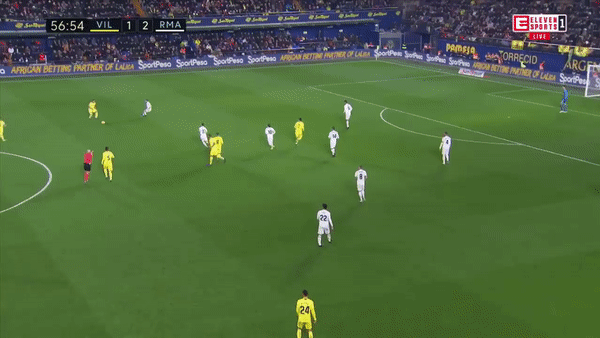 Ideally, you would want Caseres or someone else of a similar mold to be paired with a midfielder who was more of a passing hub, sort of like Lucas Torreira getting to play with Granit Xhaka and Matteo Guendouzi at Arsenal. He wouldn’t have to be burdened with unlocking defenses, and he could contribute in attack as more of a cog in a well oiled machine through recycling play, having positional awareness, and the occasional great pass. One player who’s been mildly linked to Tottenham and would have a good chance of having immediate production along with future upside is Amadou Diawara out of Napoli. Diawara has not played much for Napoli over the past three seasons, but a lot of that is due to Napoli having a bunch of really talented midfielders that they could rely on. There’s a good chance that Diawara has been more of a victim of circumstances, and he just needs to find a good club that will give him consistent minutes.
Ideally, you would want Caseres or someone else of a similar mold to be paired with a midfielder who was more of a passing hub, sort of like Lucas Torreira getting to play with Granit Xhaka and Matteo Guendouzi at Arsenal. He wouldn’t have to be burdened with unlocking defenses, and he could contribute in attack as more of a cog in a well oiled machine through recycling play, having positional awareness, and the occasional great pass. One player who’s been mildly linked to Tottenham and would have a good chance of having immediate production along with future upside is Amadou Diawara out of Napoli. Diawara has not played much for Napoli over the past three seasons, but a lot of that is due to Napoli having a bunch of really talented midfielders that they could rely on. There’s a good chance that Diawara has been more of a victim of circumstances, and he just needs to find a good club that will give him consistent minutes. 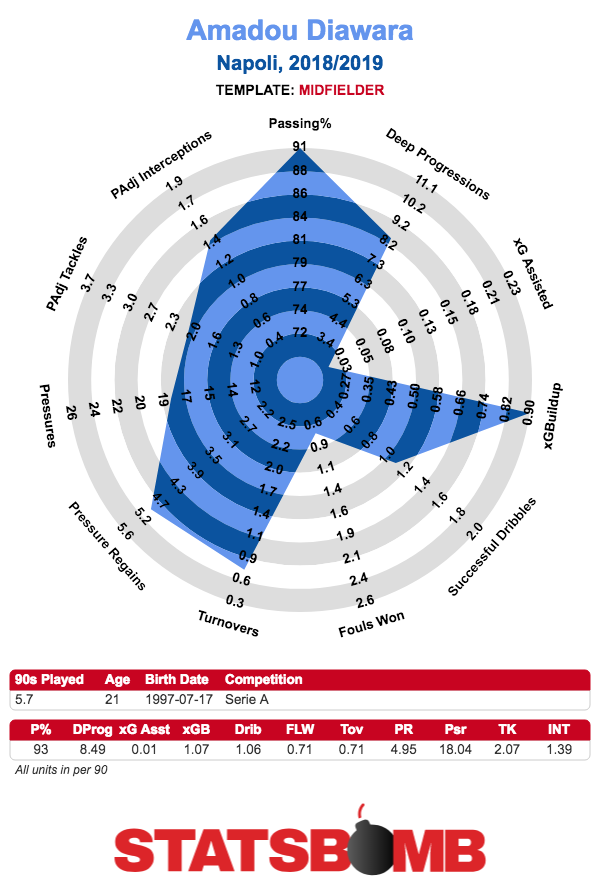 Diawara fits a lot of the requirements for the modern day defensive midfielder. He uses his intelligence and positional awareness to rack up interceptions and tackles. On offense, he is technically sound with a good understanding of his surroundings both on the ball and off of it. He makes quick decisions with his passing even while under pressure, so there’s no stuttering with trying to get the ball out of his feet. He’s not afraid to attempt vertical passes between the lines or even attempt long balls when teammates make off-ball runs.
Diawara fits a lot of the requirements for the modern day defensive midfielder. He uses his intelligence and positional awareness to rack up interceptions and tackles. On offense, he is technically sound with a good understanding of his surroundings both on the ball and off of it. He makes quick decisions with his passing even while under pressure, so there’s no stuttering with trying to get the ball out of his feet. He’s not afraid to attempt vertical passes between the lines or even attempt long balls when teammates make off-ball runs. 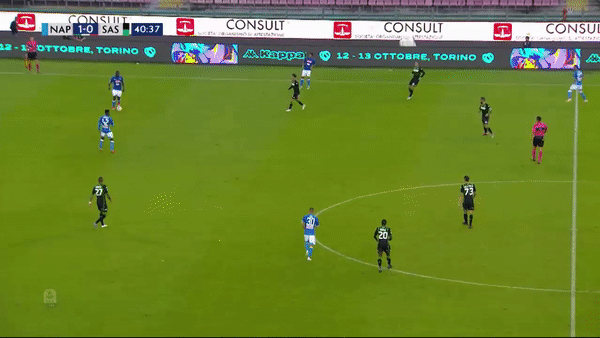 Even though Diawara has barely played over 2000 minutes spread across three seasons in Napoli, his skillset is diverse enough that he should be able to fit well with Spurs’ style of play. Perhaps the only way Spurs would be able to make a deal with Napoli would be a loan and option to buy, but it would be in their interest to pursue a move for Diawara as long as the possibility remains on the table.
Even though Diawara has barely played over 2000 minutes spread across three seasons in Napoli, his skillset is diverse enough that he should be able to fit well with Spurs’ style of play. Perhaps the only way Spurs would be able to make a deal with Napoli would be a loan and option to buy, but it would be in their interest to pursue a move for Diawara as long as the possibility remains on the table.
Fullback
In contrast to the midfield, it’s not quite as hard to find young fullbacks who could be upgrades on what Spurs currently have on the squad. A lot of that is due to Spurs’s fullbacks being a far cry from the level established by Kyle Walker and Danny Rose during the 2016-17 season when they were arguably the best duo in England. Fullback was once a strong part of Spurs approach, and it allowed them the flexibility to switch formations and styles, but now it’s become more of a source of frustration. As is customary with Ligue 1, there are several young fullbacks that have played at a high enough to warrant further consideration for Spurs. Youcef Atal has been electric in his first season in France and though Spurs do have a glut of right-backs in Aurier, Trippier, and Kyle Walker-Peters, he’s such a tantalizing young talent that he would be worth trying to acquire and he won’t cost an exorbitant amount of money. Going down the table in Ligue 1 and you’ll find other young right backs who have been productive like Enock Kwateng and Valentin Rosier. 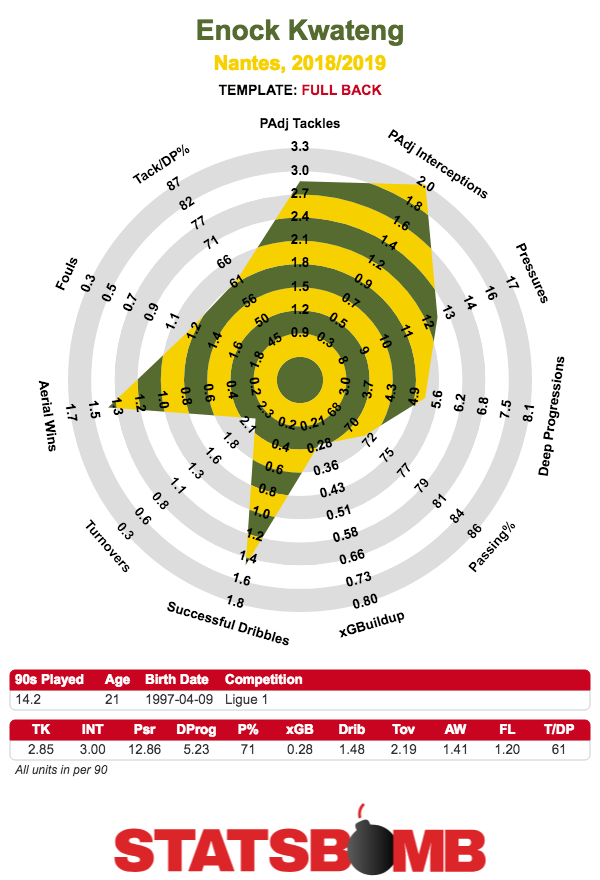
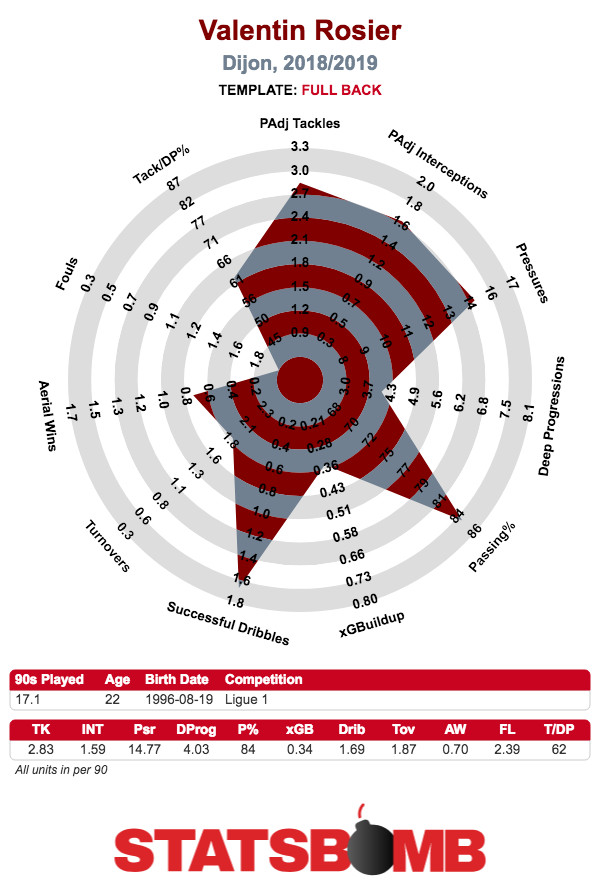 On the left side is perhaps where Spurs are a bit more concerned with getting a young talent right away. Ferland Mendy would be an obvious choice given that he’s improved from what was a strong debut season at Lyon and he has the combination of athleticism and passing needed to play at the highest level, but he’s someone who would probably be more plausible to get in the summer rather than January. In the event that Mendy is unavailable, Fode Ballo-Toure could be a viable alternative given the improvements he’s made and Lille possibly acquiescing to a move given their history of selling players to help their financial books.
On the left side is perhaps where Spurs are a bit more concerned with getting a young talent right away. Ferland Mendy would be an obvious choice given that he’s improved from what was a strong debut season at Lyon and he has the combination of athleticism and passing needed to play at the highest level, but he’s someone who would probably be more plausible to get in the summer rather than January. In the event that Mendy is unavailable, Fode Ballo-Toure could be a viable alternative given the improvements he’s made and Lille possibly acquiescing to a move given their history of selling players to help their financial books. 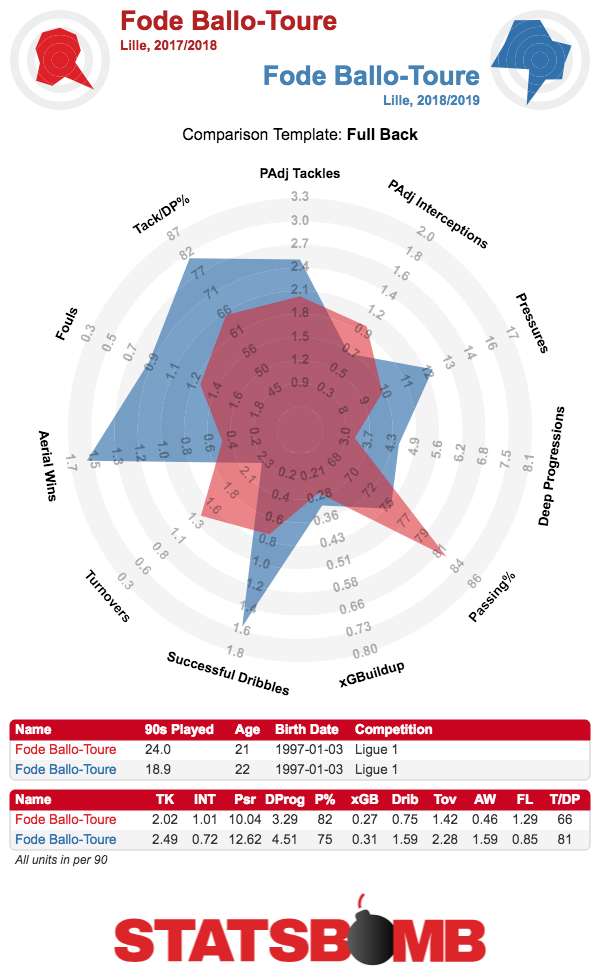 In comparison to players like Atal or Mendy, Ballo-Toure isn’t quite as dynamic on the ball. This isn’t to say that he’s a liability attacking. Ballo-Toure can make good passes whenever the wide left forward makes runs from the left halfspace to the left wing. He has the mobility to make overlapping and underlapping runs to help create space for a teammate, and he’s even sprung up in the wide left area of the penalty box every once in a while to create cutback opportunities. Defensively, Ballo-Toure has good instincts. He doesn’t over extend himself when trying to defend in isolation situations, and when he does run a fair distance to gamble with defensive actions, he’s done alright in that department.
In comparison to players like Atal or Mendy, Ballo-Toure isn’t quite as dynamic on the ball. This isn’t to say that he’s a liability attacking. Ballo-Toure can make good passes whenever the wide left forward makes runs from the left halfspace to the left wing. He has the mobility to make overlapping and underlapping runs to help create space for a teammate, and he’s even sprung up in the wide left area of the penalty box every once in a while to create cutback opportunities. Defensively, Ballo-Toure has good instincts. He doesn’t over extend himself when trying to defend in isolation situations, and when he does run a fair distance to gamble with defensive actions, he’s done alright in that department. 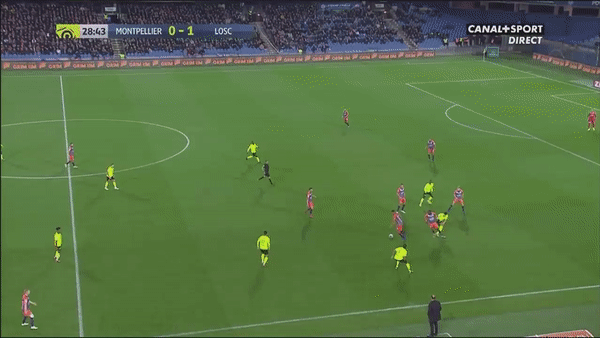 Spurs are at an interesting point in their cycle.The core of their club has largely stayed intact over the past 3-4 years, and while they were once viewed as having a young squad with room to grow during the beginning years of Pochettino’s reign, now they’ve turned into a peak age squad as their average age (weighted by minutes) is bang on with the league average at 26.9. Their attempts at supplementing their core have come with mixed results. While they’ve had their successes, they’ve also had a number of moves that didn’t work out and the odds of them working out weren’t high to begin with. Despite the fair criticisms that can be levied at their approach to transfers, Spurs have continued to punch above their weight over the past three seasons by finishing in the top 4 despite having finances that would suggest otherwise. This has been the most successful stretch for Spurs in their modern history, but without some youthful injection into the squad as soon as possible, they run the risk of becoming too stale. Header Image courtesy of the Press Association
Spurs are at an interesting point in their cycle.The core of their club has largely stayed intact over the past 3-4 years, and while they were once viewed as having a young squad with room to grow during the beginning years of Pochettino’s reign, now they’ve turned into a peak age squad as their average age (weighted by minutes) is bang on with the league average at 26.9. Their attempts at supplementing their core have come with mixed results. While they’ve had their successes, they’ve also had a number of moves that didn’t work out and the odds of them working out weren’t high to begin with. Despite the fair criticisms that can be levied at their approach to transfers, Spurs have continued to punch above their weight over the past three seasons by finishing in the top 4 despite having finances that would suggest otherwise. This has been the most successful stretch for Spurs in their modern history, but without some youthful injection into the squad as soon as possible, they run the risk of becoming too stale. Header Image courtesy of the Press Association
StatsBomb Transfer Podcast: Chelsea, Denis Suarez & Reader Qs
Mourinho, Motivation and a Manager's Job
Jose Mourinho, as you may have heard, is no longer the manager of Manchester United. The team has been good and fun, albeit against bad teams, without him. This has occasioned a great deal of hand-wringing about players somehow letting their manager down. The theory seems to be that the manager would still have a job if all of his players had just performed much better, which is a truism that applies to basically every firing. That necessarily also means the manager failed to get the most out of his players. Oh, what a conundrum!
Faced with this interpretive impasse, there’s often an inclination to shrug the whole thing off as fundamentally unresolveable — football’s version of “which came first: the chicken or the egg?” or the maxim that you can never truly know what’s going on in someone else’s marriage. Football journalists are wont to Gotta Hear Both Sides the situation, simultaneously tsk-tsking about managerial competence and player power.
Such posturing fundamentally misrepresents the roles of the various parties involved. This is not a complicated issue: It is the manager’s job to get the most out of their players.
Football, for some reason, makes people forget everything they know about workplaces. Maybe it’s all the 000s at the end of sums. In any other context, it’s not news that fulfilling your obligations to your employer and giving it your all are not the same thing. This is why working to rule — doing exactly what your contract demands and nothing more — is a common organized labor pressure tactic. The job of a manager is to get more output from employees. This entails putting people in positions where they can succeed and motivating them. Getting more out of workers, whether in an office building or on the football pitch, is how managers justify their employment.
The language of football obfuscates this dynamic. Commentators regularly — and embarrassingly — talk about players “giving 110 percent,” as if the baseline performance is 100 percent — giving your all, giving 100 percent. Nonsense. If we must put percentages on this, which we really mustn’t, the baseline is somewhere in the 80s. Players will basically do their jobs in a variety of situations. That is sometimes enough to win, but clubs understandably value a manager who can get more out of players.
We tend not to talk about motivation in stats-land. It’s not easily quantifiable. Player talent and tactical choices tend to win out over people skills, so that’s what gets most of the attention. But motivation is a part of tactics. If you want your players to track back or run their hearts out or subsume themselves to some greater goal, you need to convince them to actually do those things. Motivation therefore tends to gets absorbed into the vague category we think of “tactics.” That doesn’t make it any less real.
Curiously, the notion that motivation is the manager’s responsibility was never contested when Mourinho was successful. At Inter, he was lauded for talking strikers into fulfilling other roles. He talked Samuel Eto’o — Samuel Eto’o!!! — into being a winger. At Real Madrid, before everything went south, he turned Ángel di María into a two-way winger and talked Mesut Ozil into tracking back, at least for 60 minutes a match. Mourinho didn’t invent the deep block or tracking back or eschewing possession; his real innovation was getting 21st century superstars to go along with those ideas. Leaving aside the question of whether such tactics remain wise, elite clubs hired Mourinho because he, unlike one-and-done Manchester United manager David Moyes, could get stars to go along with these schemes. At the point where he could no longer deliver that, of course he was fired.
This, inescapably, is where we have to talk about ‘player power.’ The term has no clear definition and seems to have come to refer to any act of player agency that the interlocutor dislikes. (It also seems to come up a lot more about non-white players exercising the slightest semblance of agency.) Of course players have power! They’re the ones who actually have to do things on the pitch. They are rare talents. They are expensive investments who only peak for a few years. Of course clubs wish to get the most out of these investments, which gives the players a certain amount of sway. If clubs think a player is the real problem, they can sell them. That, however, is rare because clubs exist to get the most out of players and managers are just a means to that end. (During previous Mourinho meltdowns, clubs have done just this to no real effect.) The existence of ‘player power,’ whatever that means, does not lessen Mourinho’s responsibility for motivating his players.
Ole Gunnar Solskjær, Manchester United’s interim manager, has the distinct advantage of not being a miserable dick. That is not nothing. Manchester United has spent heavily on Paul Pogba, Romelu Lukaku and Anthony Martial and is counting on Marcus Rashford to extend the mystique of its academy. The club, as should have been obvious to Jose Mourinho and everyone else, wants a manager who gets those players to perform well and want to stay at the club. Getting along with a talented squad isn’t enough to win a title, but it’s enough to improve on Mourinho’s final season, a season which produced numbers closer to mid-table Leicester than a top-6 side. At this early date, there’s no sign that Solskjær has the tactical ideas needed to defeat a Jurgen Klopp or Pep Guardiola side. The changes at Old Trafford are nevertheless a reminder of one of football’s eternal truths: It’s the manager’s job to motivate players.
Chelsea and the Challenge of Sarriball
Have Chelsea gotten better? Changing managers can frequently cause some degree of upheaval. Old systems are discarded and new ones are implemented. Squads which had been constructed to play in one manner must be repurposed for another. There’s friction. The hope is that as a new manager settles in, friction eases the squad learns what it’s doing, and away we go. That idea is what made the start to Chelsea’s season so enticing. Despite the friction, the team started with five straight victories. They didn’t lose their first match until November 24. If they were getting great results before the manager settled in, imagine what would happen as the season progressed. The problem is, here’s what’s happened as the season has progressed. 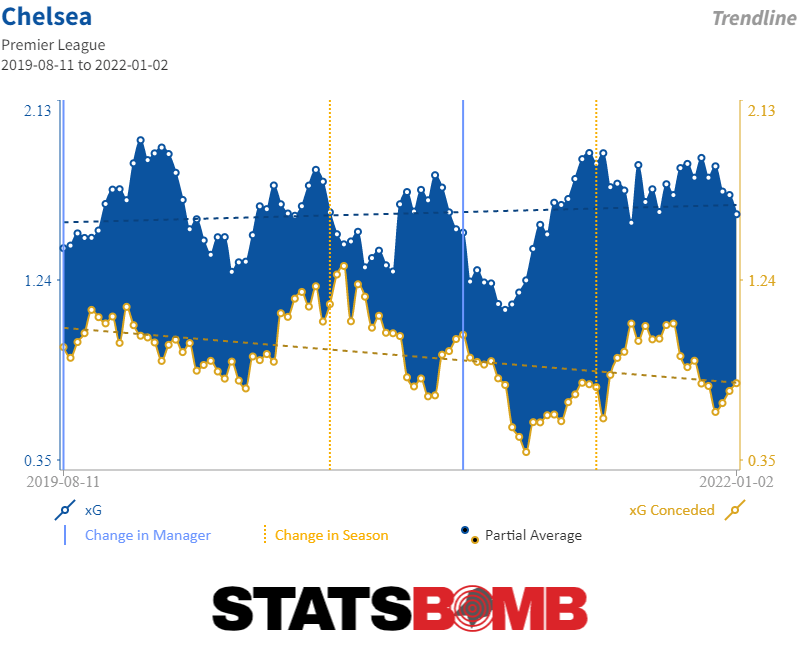 That’s a ten-game rolling average of Chelsea’s expected goals, and expected goals conceded, starting from the beginning of last season. Thanks to Chelsea’s very poor attacking start to the 2017-18 campaign one which ultimately doomed their season, their attacking trendline seems to be improving. But, at the same time recent attacking results have been absolutely terrible. The team is mired in the midst of a four-match slump with narrow wins against Watford and Crystal Palace sandwiched between a loss to Leicester and a 0-0 draw against Southampton, both at home. The problem isn’t that Chelsea don’t create scoring opportunities. In both the loss and the draw, they more than their season average of 15.81 shots, an average which is itself the second highest in the league. The problem is that so few of those shots are good. Their xG per shot of 0.10 is exceedingly average. Only nine teams take worse quality shots on average than Chelsea do. The combination of high volume attack and average quality makes for the third best attack in the league by expected goals, clocking in at 1.51 per game. Pounding away until something unlikely goes in the net is certainly a strategy that can work, but when it goes wrong it goes particularly ugly. Against Southampton the team’s ability to create shots dropped even further. Of their 16 shots against Southampton only five were 0.10 xG or above, and that’s how you end up with 16 shots totaling a grand total of one expected goal.
That’s a ten-game rolling average of Chelsea’s expected goals, and expected goals conceded, starting from the beginning of last season. Thanks to Chelsea’s very poor attacking start to the 2017-18 campaign one which ultimately doomed their season, their attacking trendline seems to be improving. But, at the same time recent attacking results have been absolutely terrible. The team is mired in the midst of a four-match slump with narrow wins against Watford and Crystal Palace sandwiched between a loss to Leicester and a 0-0 draw against Southampton, both at home. The problem isn’t that Chelsea don’t create scoring opportunities. In both the loss and the draw, they more than their season average of 15.81 shots, an average which is itself the second highest in the league. The problem is that so few of those shots are good. Their xG per shot of 0.10 is exceedingly average. Only nine teams take worse quality shots on average than Chelsea do. The combination of high volume attack and average quality makes for the third best attack in the league by expected goals, clocking in at 1.51 per game. Pounding away until something unlikely goes in the net is certainly a strategy that can work, but when it goes wrong it goes particularly ugly. Against Southampton the team’s ability to create shots dropped even further. Of their 16 shots against Southampton only five were 0.10 xG or above, and that’s how you end up with 16 shots totaling a grand total of one expected goal.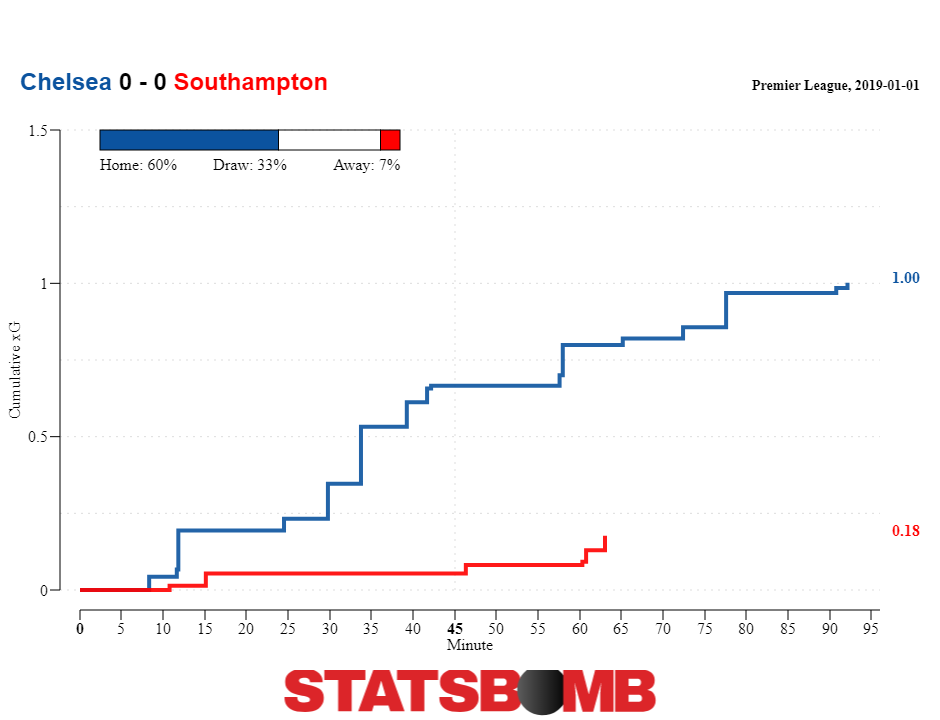 The ultimate numbers were somewhat better in the Leicester loss, 1.40 xG from 17 shots, but the bulk of the match wouldn’t feel that way since Chelsea’s last two shots, a header from Rudiger in the 88th minute and then Marcos Alonso through on goal in the 92nd that combined for 0.54 worth of xG. Before that point Chelsea’s 15 shots had amounted for a grand total of 0.85 xG.
The ultimate numbers were somewhat better in the Leicester loss, 1.40 xG from 17 shots, but the bulk of the match wouldn’t feel that way since Chelsea’s last two shots, a header from Rudiger in the 88th minute and then Marcos Alonso through on goal in the 92nd that combined for 0.54 worth of xG. Before that point Chelsea’s 15 shots had amounted for a grand total of 0.85 xG. 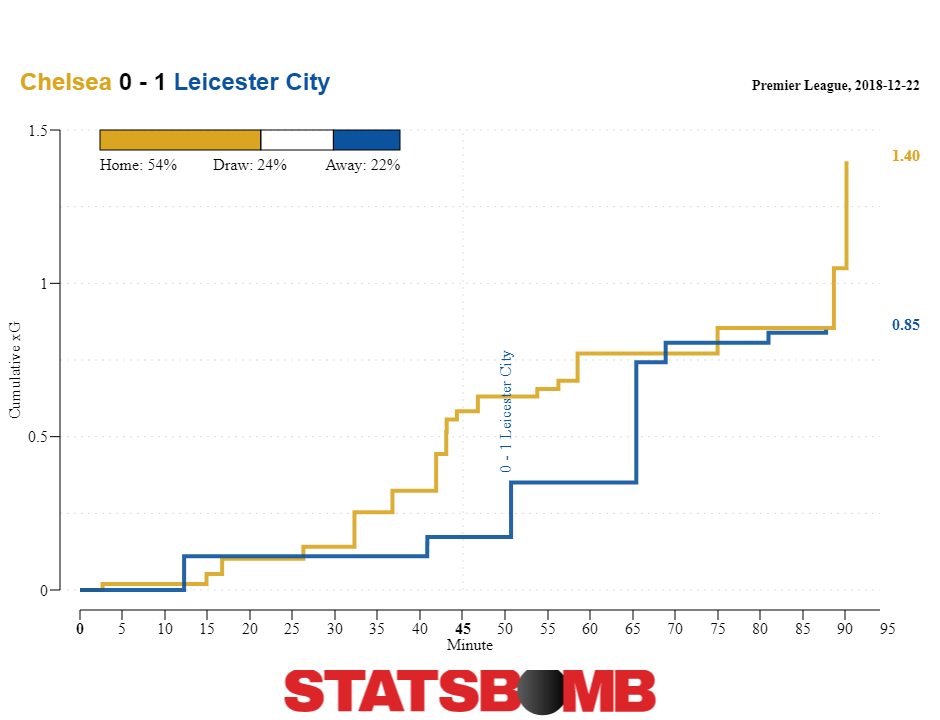 Boring old high possession, high shot volume styles can work. And broadly, it’s important to note, that it is working for Chelsea. Despite their indifferent form over the festive period the team sits in fourth place, and has the third best xG difference, 0.66, in the Premier League. Chelsea are good. They’re probably going to qualify for the Champions League. That’s not something to sneeze at. They’re just not any better than they were. This season they’re at 1.51 xG per match. Last season they were at 1.45. They’re conceding 0.85 xG per match, last season it was 0.89. They aren’t even really all that different when it comes to shot numbers. They’re taking 15.81 this season, they actually took more, 16.13, last year. The only place where the shots look different statistically is on defense where the team is conceding fewer shots, 8.86 to 10.05 but also worse ones. Chelsea average xG per shot conceded has ticked up slightly from 0.09 to 0.10. For all the talk about Sarri ball, and the new emphasis on possession and the switch from a back three to a back four. None of it has moved the needle when it comes to results, or even underlying shot numbers. Chelsea certainly play differently, but they aren’t playing any better. Under Antonio Conte the team was defensively strong and uninterested in possession. When they forced turnovers they would try to beat their opponent down the field, and when that failed they’d take a speculative shot rather than sacrifice their defensive positioning. And then they’d do it all over agan. Under Sarri, the team’s approach is entirely different. They want to use the ball and break opponents down, they want to take good shots after carving opponents apart. The problem is that they are failing to do that. So, when they prove unable to break opponents down, they take speculative shots, press to get the ball back and then do it all over again. The hope was, and remains, that Sarri could tactically elevate the squad beyond the performances that Conte got. So far Chelsea’s new style, while it certainly is different, hasn’t made them better. Sarri has faced distinct challenges in the Premier League. Most teams are simply uninterested in pressing the ball, even when Chelsea’s midfield, led by Joginho try and draw them out. The teams that do press are generally quite good at it. And so Chelsea are left smashing their head against defenses that sit deeper and are less inclined to shift to and from the ball than they were in Italy. Another major problem is that Mateo Kovacic, after a promising start, has failed to become a real attacking presence from midfield. And while Ross Barkley, as ever, has the physical tools to succeed, he has, as ever, not demonstrated the tactical awareness to be a complementary attacker in this system. Sarri’s system depends on midfielders breaking lines and then breaking into the box. Marek Hamsik went from great to superstar filling this role for Sarri at Napoli. None of this means that Chelsea can’t develop. They can. But, it also might take another round of purchases. Cristian Pulisic fills part of that need. He’ll certainly play lots of minutes on the wing, given Pedro and Willian’s age, but he could also end up slotting into that midfield role. Chelsea are also rumored to be casting around for a striker, with Alvaro Morata frequently benched, Olivier Giroud frequently old, and Eden Hazard frequently needed in his natural wing position. At some point though filling those holes changes the story. Bringing in more talented players will certainly improve the squad. And, to some degree, which players are purchased will be dictated by which holes Sarri need to fill. But, at the same time getting Sarri better players to make the team better isn’t really Sarri’s tactics improving Chelsea, it’s the fact that more and better players are being added to the team. It’s too early to write off Sarri, but the first half of his first season with Chelsea illuminates the major challenge that managers face. It’s easy to change how a team plays. It’s incredibly hard to change how good they are.
Boring old high possession, high shot volume styles can work. And broadly, it’s important to note, that it is working for Chelsea. Despite their indifferent form over the festive period the team sits in fourth place, and has the third best xG difference, 0.66, in the Premier League. Chelsea are good. They’re probably going to qualify for the Champions League. That’s not something to sneeze at. They’re just not any better than they were. This season they’re at 1.51 xG per match. Last season they were at 1.45. They’re conceding 0.85 xG per match, last season it was 0.89. They aren’t even really all that different when it comes to shot numbers. They’re taking 15.81 this season, they actually took more, 16.13, last year. The only place where the shots look different statistically is on defense where the team is conceding fewer shots, 8.86 to 10.05 but also worse ones. Chelsea average xG per shot conceded has ticked up slightly from 0.09 to 0.10. For all the talk about Sarri ball, and the new emphasis on possession and the switch from a back three to a back four. None of it has moved the needle when it comes to results, or even underlying shot numbers. Chelsea certainly play differently, but they aren’t playing any better. Under Antonio Conte the team was defensively strong and uninterested in possession. When they forced turnovers they would try to beat their opponent down the field, and when that failed they’d take a speculative shot rather than sacrifice their defensive positioning. And then they’d do it all over agan. Under Sarri, the team’s approach is entirely different. They want to use the ball and break opponents down, they want to take good shots after carving opponents apart. The problem is that they are failing to do that. So, when they prove unable to break opponents down, they take speculative shots, press to get the ball back and then do it all over again. The hope was, and remains, that Sarri could tactically elevate the squad beyond the performances that Conte got. So far Chelsea’s new style, while it certainly is different, hasn’t made them better. Sarri has faced distinct challenges in the Premier League. Most teams are simply uninterested in pressing the ball, even when Chelsea’s midfield, led by Joginho try and draw them out. The teams that do press are generally quite good at it. And so Chelsea are left smashing their head against defenses that sit deeper and are less inclined to shift to and from the ball than they were in Italy. Another major problem is that Mateo Kovacic, after a promising start, has failed to become a real attacking presence from midfield. And while Ross Barkley, as ever, has the physical tools to succeed, he has, as ever, not demonstrated the tactical awareness to be a complementary attacker in this system. Sarri’s system depends on midfielders breaking lines and then breaking into the box. Marek Hamsik went from great to superstar filling this role for Sarri at Napoli. None of this means that Chelsea can’t develop. They can. But, it also might take another round of purchases. Cristian Pulisic fills part of that need. He’ll certainly play lots of minutes on the wing, given Pedro and Willian’s age, but he could also end up slotting into that midfield role. Chelsea are also rumored to be casting around for a striker, with Alvaro Morata frequently benched, Olivier Giroud frequently old, and Eden Hazard frequently needed in his natural wing position. At some point though filling those holes changes the story. Bringing in more talented players will certainly improve the squad. And, to some degree, which players are purchased will be dictated by which holes Sarri need to fill. But, at the same time getting Sarri better players to make the team better isn’t really Sarri’s tactics improving Chelsea, it’s the fact that more and better players are being added to the team. It’s too early to write off Sarri, but the first half of his first season with Chelsea illuminates the major challenge that managers face. It’s easy to change how a team plays. It’s incredibly hard to change how good they are.
Loan Watch: How Are Premier League Prospects Across Europe Faring?
According to Transfermarkt’s somewhat conservative figures, Premier League clubs currently have 125 players out on loan. Given that Chelsea alone would seem to have more than double the number quoted by that site, the real total could well be north of 150. While many are placed within the English pyramid, others are given a spot on European teams. There are two primary reasons teams loan out a young player: to further their development or to increase their market value. While both can often be served by a loan in the Championship, a move abroad can open a young player up to different experiences and approaches, benefiting both their on and off-field growth. This article focuses on the younger players, 23 or under, who have been placed further afield across some of the biggest leagues in Europe. Players who will hope to impress sufficiently to earn themselves a role in the first team squads of their respective teams next season.
Reiss Nelson
Arsenal would have struggled to find a better landing spot for 19-year-old Reiss Nelson than Hoffenheim. A Champions League club, located in a quiet, university city short on off-field distractions, led by an intelligent young coach who asks a lot of his players, it has proved to be an excellent environment for him to get minutes and develop his game.  His radar shows a player who is making a solid overall attacking contribution without yet standing out in any particular area. A combined 0.43 xG + xGA per 90 is very decent for his age and also carries over into the smaller sample of his Champions League appearances, in which he recorded a combined 0.38xG + xGA per 90. Nelson’s initial position has largely been on the left flank, with license to cut inside onto his favoured right foot, but Julian Nagalsmann is a coach who regularly rotates the roles and positions of his players, and that is very much evident in the split of Nelson’s per 90s to date.
His radar shows a player who is making a solid overall attacking contribution without yet standing out in any particular area. A combined 0.43 xG + xGA per 90 is very decent for his age and also carries over into the smaller sample of his Champions League appearances, in which he recorded a combined 0.38xG + xGA per 90. Nelson’s initial position has largely been on the left flank, with license to cut inside onto his favoured right foot, but Julian Nagalsmann is a coach who regularly rotates the roles and positions of his players, and that is very much evident in the split of Nelson’s per 90s to date.  Nelson scored six times in his first couple of months in the Bundesliga off of just 11 shots and 1.38xG, but has unsurprisingly cooled down since.
Nelson scored six times in his first couple of months in the Bundesliga off of just 11 shots and 1.38xG, but has unsurprisingly cooled down since.  His performance levels have also gone through peaks and troughs, with accompanying praise and criticism from his coach, but that is to be expected given his inexperience. Even though only five of his 18 appearances in league and Champions League play have been starts, he is getting more minutes than he would have done at Arsenal and is performing well enough to merit continued inclusion. His ability on the dribble at times been decisive.
His performance levels have also gone through peaks and troughs, with accompanying praise and criticism from his coach, but that is to be expected given his inexperience. Even though only five of his 18 appearances in league and Champions League play have been starts, he is getting more minutes than he would have done at Arsenal and is performing well enough to merit continued inclusion. His ability on the dribble at times been decisive. 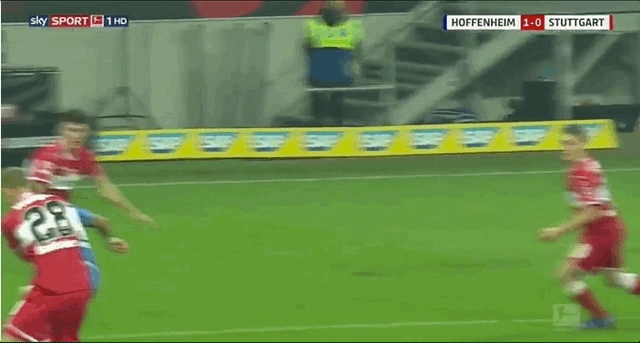 Nelson isn’t ripping up the league to the same degree as his fellow South-Londoner and former Southwark Under-11 teammate Jadon Sancho at Borussia Dortmund, but he is doing enough to suggest he has a bright future ahead of him. Reports this week suggest that senior figures at Arsenal are keen to see him remain at Hoffenheim until the end of the season, despite coach Unai Emery expressing an interest in recalling him in January. When he does return in the summer, he will do so as both a better player and a more valuable asset.
Nelson isn’t ripping up the league to the same degree as his fellow South-Londoner and former Southwark Under-11 teammate Jadon Sancho at Borussia Dortmund, but he is doing enough to suggest he has a bright future ahead of him. Reports this week suggest that senior figures at Arsenal are keen to see him remain at Hoffenheim until the end of the season, despite coach Unai Emery expressing an interest in recalling him in January. When he does return in the summer, he will do so as both a better player and a more valuable asset.
Manu García
For a third consecutive season, Manchester City have loaned out attacking midfielder Manu García. Having just turned 21, this is arguably one of the last opportunities he has to convince the club that he is worthy of joining the first team group. After half a season at Alaves in his native Spain and 18 months at NAC Breda in the Netherlands, this time around he finds himself in France as part of a lower mid-table Toulouse side. It was a move that García was happy to make, aware that performing well in a physical league like Ligue 1 would help prove that his small, 5-foot-7 frame would not be an impediment to future success. He has had plenty of playing time, registering 15 starts and a further two substitute appearances, but results so far have been mixed.  Usually deployed as a central attacking midfielder, he has showed himself to be an able dribbler and foul winner who doesn’t give the ball away too much, links neatly and is able to provide a solid off-ball contribution in terms of pressures and pressure regains. But he has contributed very little in the final third, barely advancing into the area and producing just 0.10xG + xGA per 90. He has notched zero goals and two assists to date. His profile as a central midfielder, a role he has occupied at times, also provides little to suggest that he has a long-term future at City.
Usually deployed as a central attacking midfielder, he has showed himself to be an able dribbler and foul winner who doesn’t give the ball away too much, links neatly and is able to provide a solid off-ball contribution in terms of pressures and pressure regains. But he has contributed very little in the final third, barely advancing into the area and producing just 0.10xG + xGA per 90. He has notched zero goals and two assists to date. His profile as a central midfielder, a role he has occupied at times, also provides little to suggest that he has a long-term future at City.  However, this is not exactly a loan that provides much opportunity to analyse that assumption. A move from a pass-and-press heavy, dominant attacking outfit to one of Ligue 1’s worst attacking teams, one who are not even particularly proactive out of possession, was never going to provide a relevant gauge of his level.
However, this is not exactly a loan that provides much opportunity to analyse that assumption. A move from a pass-and-press heavy, dominant attacking outfit to one of Ligue 1’s worst attacking teams, one who are not even particularly proactive out of possession, was never going to provide a relevant gauge of his level.
Ola Aina
According to their official website, Chelsea currently have 40 players out on loan in various locations across the globe. Some of those are first-team signings that didn’t come off, others are players approaching their mid-20s unlikely to ever turn out for the club itself, and the last group are younger youth-academy graduates and signings seeking to earn themselves a place in the first-team squad or at least secure a move elsewhere. Ola Aina falls squarely into that last-mentioned group. A two-time winner of both the FA Youth Cup and the UEFA Youth League in his time in the club’s youth system, an England youth international at various age groups and already a senior international with Nigeria, his solid if unspectacular loan spell at Hull City last season left him really needing to impress this time around. The 22-year-old had various offers on the table last summer, but he elected to join Serie A side Torino. It was a step up and a step into the unknown, but he jumped at the opportunity to improve the tactical side of his game under a detail-orientated coach like Walter Mazzarri. Throughout his youth career, Aina was a quick and strong, defensively sound full-back, two-footed, neat and tidy on the ball and an occasional presence further up the pitch. He has managed to retain those qualities whilst adding more attacking thrust to his game as a right or left-wing back in Mazzarri’s 3-5-2 formation.  Aina has exceeded pre-season expectations, starting 12 times (alongside four substitute appearances) and earning praise, alongside the odd criticism, from his coach. It seems that Torino have a €10 million purchase option on him, but Aina has made it clear that his preference would be to return to Chelsea if a first-team place is available. Depending on how their summer transfer moves work out, that doesn’t seem as unlikely a scenario as it once did.
Aina has exceeded pre-season expectations, starting 12 times (alongside four substitute appearances) and earning praise, alongside the odd criticism, from his coach. It seems that Torino have a €10 million purchase option on him, but Aina has made it clear that his preference would be to return to Chelsea if a first-team place is available. Depending on how their summer transfer moves work out, that doesn’t seem as unlikely a scenario as it once did.
Liverpool Loanees - Ojo, Grujic and Allan
After three loans to Championship teams in England, Sheyi Ojo joined French side Reims this summer. He has started just three times as part of 4.8 per 90s to date. And there has been little in his output to indicate a long-term future at Anfield awaits. He still doesn’t provide enough end product to justify his very low passing completion percentage and high number of turnovers.  Like Ojo, Marko Grujic extended his Liverpool contract before he was loaned out to Hertha Berlin last summer. A pair of ankle injuries, the latter of which is likely to keep him out of action until the end of January, have reduced his playing time to six starts and one substitute appearance. When he has been on the field, the 22-year-old’s output has been steady at best.
Like Ojo, Marko Grujic extended his Liverpool contract before he was loaned out to Hertha Berlin last summer. A pair of ankle injuries, the latter of which is likely to keep him out of action until the end of January, have reduced his playing time to six starts and one substitute appearance. When he has been on the field, the 22-year-old’s output has been steady at best.  Allan also signed a new deal before departing for his fifth consecutive loan away from Anfield. The Brazilian midfielder, signed from Internacional back in 2015, has never appeared for Liverpool’s first team. He made just two starts and two substitute appearances for Eintracht Frankfurt before suffering knee ligament damage in November that will sideline him until mid-January. More minutes will be necessary to draw conclusions.
Allan also signed a new deal before departing for his fifth consecutive loan away from Anfield. The Brazilian midfielder, signed from Internacional back in 2015, has never appeared for Liverpool’s first team. He made just two starts and two substitute appearances for Eintracht Frankfurt before suffering knee ligament damage in November that will sideline him until mid-January. More minutes will be necessary to draw conclusions. 
Nikola Vlasic
Everton parted with £10 million to sign Nikola Vlasic from Hadjuk Split in the summer of 2017, but he never really got a proper run in the side during his first year in England. He only once started consecutive league matches as part of seven starts and five substitute appearances. Attacking arrivals midway through that season and at the start of the current campaign pushed him further down the pecking order. So Everton sent him out on loan to CSKA Moscow, where he was a standout performer during the Champions League group stage for a side who somehow contrived to finish bottom of their group despite defeating Real Madrid home and away. Playing in a variety of positions across the attacking midfield line, he provided a combined 0.24xG + xGA per 90, yielding one non-penalty goal (plus two penalties) and two assists for a scoring contribution of 0.47 per 90. He most impressed with his ability to progress the ball forward on the pass and the dribble. He led his side in successful dribbles and deep progressions, and ranked second in terms of moving the ball into the penalty area. What he provided to his team sat somewhere between a midfielder.  And an attacking midfielder/winger.
And an attacking midfielder/winger.  Given the quality of opposition, with Roma and Viktoria Plzen the other two teams in the group, this relatively small sample suggests Everton have a player with a very interesting skillset who is capable of taking on a more central role than the right wing position he was generally assigned last season. Will he get the opportunity to show it?
Given the quality of opposition, with Roma and Viktoria Plzen the other two teams in the group, this relatively small sample suggests Everton have a player with a very interesting skillset who is capable of taking on a more central role than the right wing position he was generally assigned last season. Will he get the opportunity to show it?
Window Shopping: Nice's Youcef Atal, a Potential Star Fullback in the Making
The fullback position has never been more important.
At the highest level, fullbacks have the unenviable task of moonlighting as another attacking player during possession, stretching the opposition, knowing when to attack the space behind the opposition defense, all the while having enough spark off the dribble to beat his marker and get into the final third with speed for crossing opportunities. In addition, these fullbacks must have the ability to track back and cover lots of ground or else risk being labeled a liability defensively. Different clubs have taken different approaches to addressing the fullback position: some have spent top dollar on premium options, others have looked to more cost effective measures to get close to equal value. Either way you slice it, it’s become almost impossible to compete at the top of the game without high level fullbacks.
That’s what makes Youcef Atal such an intriguing prospect, and one who’s been gaining some steam within niche parts of Football Twitter. At 22, Atal is at the right age to target for higher level clubs abroad. The fullback position is arguably the one that demands the highest level of athleticism, so the peak years in their hypothetical aging curve is perhaps a bit earlier than elsewhere on the pitch. Combine his young age with the impressive production, and you got yourself quite the tantalizing option.
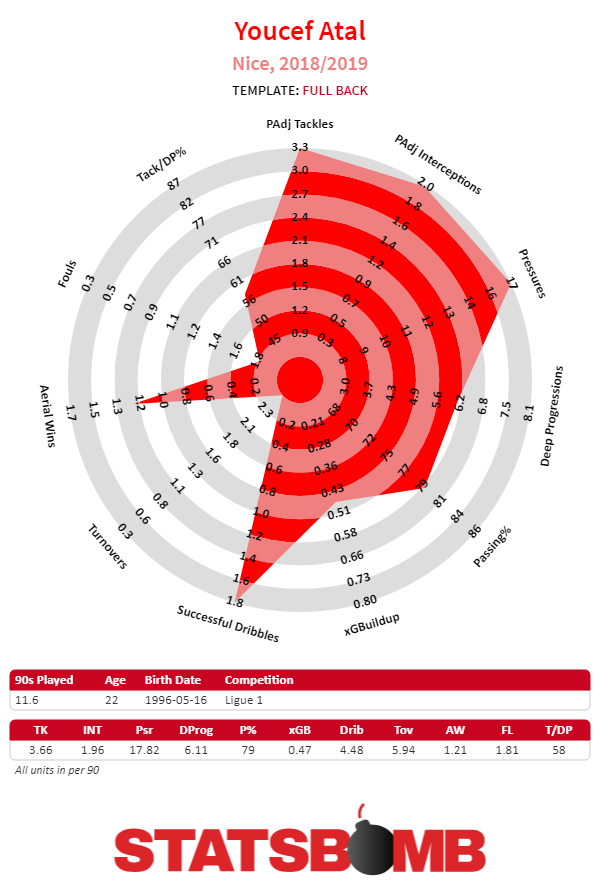
The thing that sticks out with Atal’s production is the high volume of dribbles and turnovers he’s piled up. While there’s an expectation that fullbacks who fly up and down the pitch will have noteworthy self creation numbers, Atal is on the extreme end of things and has dribbling and turnover numbers that more resembles what you would expect from high usage attackers like Eden Hazard or Allan Saint-Maxamin. When Atal gets older and probably gets himself onto a better team with better surrounding talent, those numbers will go down, but it is noteworthy that his statistical resume includes those outliers.
Atal’s positioning is what you would expect from the modern day fullback. During buildup he's very high, allowing the wingers to cut inside into the halfspace and occupy that part of the pitch. When the opposition brings their line higher up, Atal will get himself almost aligned with the defensive line to try and take advantage of long passes.
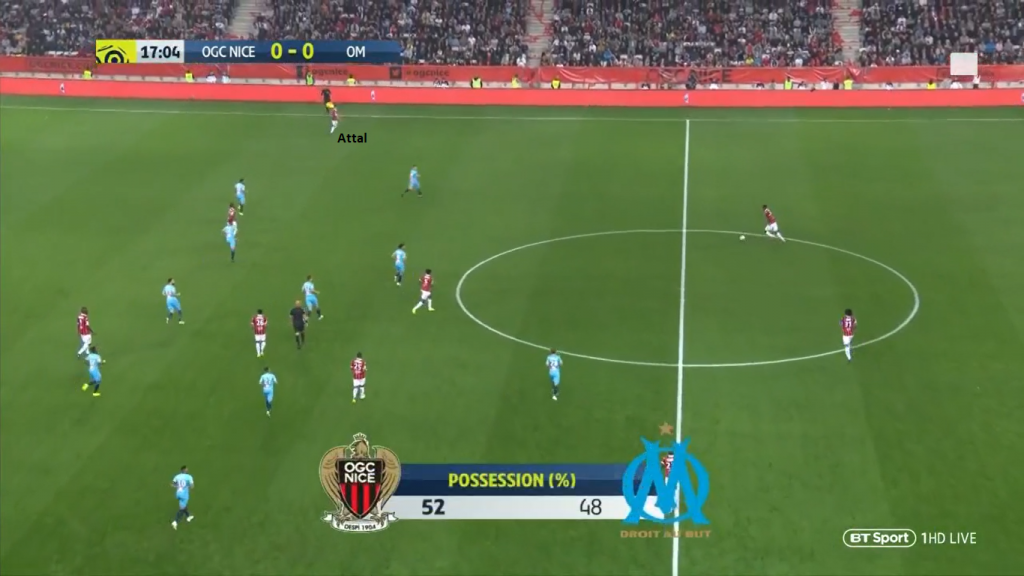
Off-ball awareness in terms of trying to exploit space is something that Atal shows the capabilities of doing. When there's an opportunity to attack the opposition in semi-transition, he'll make the standard fullback play of overlapping the ball carrier to the outside and be an option to dump the ball off for an incoming cross. If a player on Nice is occupying the right half space, he'll move up to receive the ball and drag his marker with him, opening up space for Atal to be open for either the direct lob from the CB or having the player in the halfspace one touch a pass for Atal to receive. Atal is constantly on his toes trying to run into space whenever possible, trying to creep forward from the blindside of his marker.
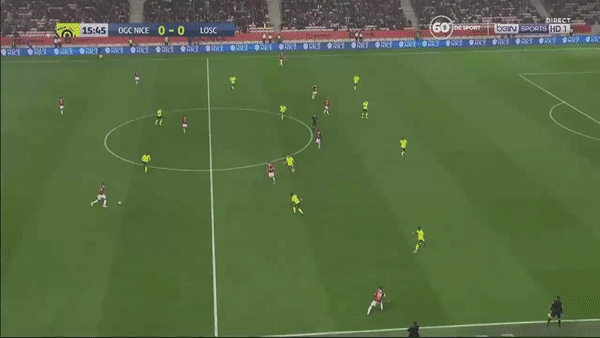 Having awareness off the ball is valuable, and any assessment of Atal's ability as a fullback should mention this aspect to his game. Having said that, the meat and potatoes with Atal's skillset lies in his ability on-ball. At his best, he can be electric. With his combination of burst and ability use his body to shield the ball from opponents once he gets a step on his marker, he can be a handful for opponents to deal with. He takes his fair share of crosses, though he's not at the point where he could be considered a high end crosser as a fullback. Atal's passing is better shown when he's attempting to create short lead passes for the wide player to receive and run into the penalty box. If he's not beating his man off the dribble, he'll try to use his teammate and initiate combinations where a short pass is made and a one touch lob pass is attempted that Atal tries to get on the end of.
Having awareness off the ball is valuable, and any assessment of Atal's ability as a fullback should mention this aspect to his game. Having said that, the meat and potatoes with Atal's skillset lies in his ability on-ball. At his best, he can be electric. With his combination of burst and ability use his body to shield the ball from opponents once he gets a step on his marker, he can be a handful for opponents to deal with. He takes his fair share of crosses, though he's not at the point where he could be considered a high end crosser as a fullback. Atal's passing is better shown when he's attempting to create short lead passes for the wide player to receive and run into the penalty box. If he's not beating his man off the dribble, he'll try to use his teammate and initiate combinations where a short pass is made and a one touch lob pass is attempted that Atal tries to get on the end of. 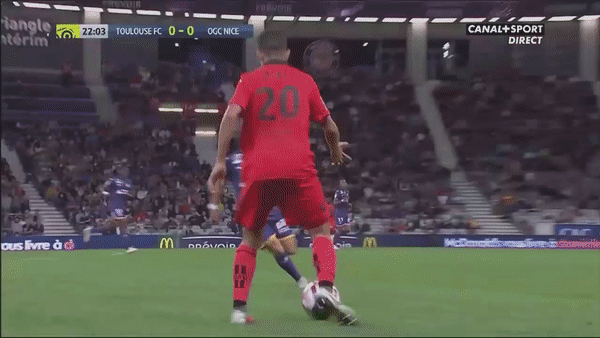 One of the things that Atal does quite well is that he leverages his ability off the dribble to get himself in the right wide areas of the box for cross-box passes instead of settling for crosses. While not all crosses are equal in terms of value, crosses aren't the most efficient way of building an attack, especially crosses from further away. With Atal's burst, he's not shy about trying to get an advantage and hunt for a more dangerous pass. Sometimes this doesn't end well and he gets knocked off the ball, or even the first dribble attempt around midfield goes nowhere, but there's value to be had in having a fullback who's flashed the ability to create the kind of chaos in the penalty box that is more associated with wingers.
One of the things that Atal does quite well is that he leverages his ability off the dribble to get himself in the right wide areas of the box for cross-box passes instead of settling for crosses. While not all crosses are equal in terms of value, crosses aren't the most efficient way of building an attack, especially crosses from further away. With Atal's burst, he's not shy about trying to get an advantage and hunt for a more dangerous pass. Sometimes this doesn't end well and he gets knocked off the ball, or even the first dribble attempt around midfield goes nowhere, but there's value to be had in having a fullback who's flashed the ability to create the kind of chaos in the penalty box that is more associated with wingers. 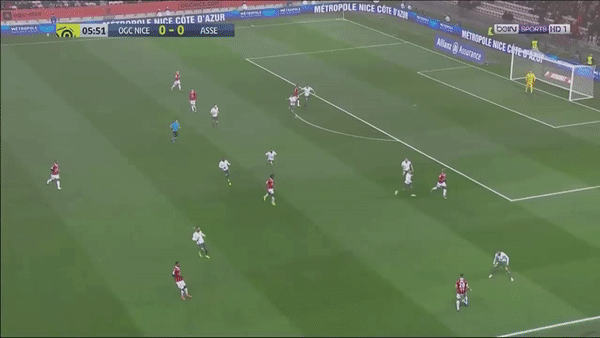 It's clear that Atal has been a net positive going forward, albeit the manner in which he's done it has been in some ways atypical. That does makes you wonder a little bit if his performance would translate on a different team. Atal's defensive work has been a bit more questionable, even while his defensive numbers which are about as good as you could reasonably expect from a fullback. Atal has been used as a rightback and right wingback in different formations this season, and that's helped make his defensive activity standout because he's quite active from one end of the pitch to the other.
It's clear that Atal has been a net positive going forward, albeit the manner in which he's done it has been in some ways atypical. That does makes you wonder a little bit if his performance would translate on a different team. Atal's defensive work has been a bit more questionable, even while his defensive numbers which are about as good as you could reasonably expect from a fullback. Atal has been used as a rightback and right wingback in different formations this season, and that's helped make his defensive activity standout because he's quite active from one end of the pitch to the other. 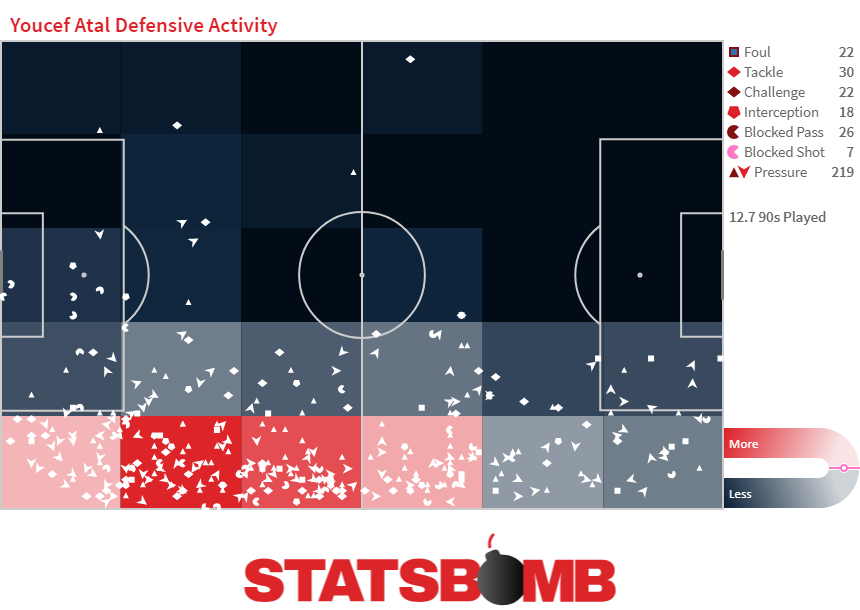 One of the things that's noticeable with Atal is that he is not afraid to take chances defensively. When he recognizes that there's an awkward first touch for an opponent to the right wing and that forces him to have his back towards goal with his first touch, he'll charge ahead and immediately put pressure on him. That's a good thing when taking into account where football is currently with very good-elite teams using a bad first touch as a pressing trigger to try and force turnovers. What's a bit more worrying is that Atal gets himself into situations where he gambles for a tackle/interception and completely whiffs on it, which can lead to possible counter attacks going the other way.
One of the things that's noticeable with Atal is that he is not afraid to take chances defensively. When he recognizes that there's an awkward first touch for an opponent to the right wing and that forces him to have his back towards goal with his first touch, he'll charge ahead and immediately put pressure on him. That's a good thing when taking into account where football is currently with very good-elite teams using a bad first touch as a pressing trigger to try and force turnovers. What's a bit more worrying is that Atal gets himself into situations where he gambles for a tackle/interception and completely whiffs on it, which can lead to possible counter attacks going the other way. 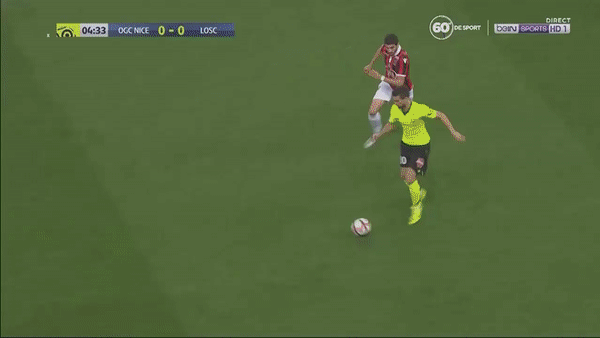 In terms of off-ball awareness defensively, Atal is generally aware of where he is and where his marker is, so he doesn't lose track of someone creeping on his blindside and springing open to receive a pass in an advantageous position. Even when that does happen though, Atal has shown the requisite speed to make up for it and snuff out any further danger. Though, it's an open question whether that will continue against higher level competition.
In terms of off-ball awareness defensively, Atal is generally aware of where he is and where his marker is, so he doesn't lose track of someone creeping on his blindside and springing open to receive a pass in an advantageous position. Even when that does happen though, Atal has shown the requisite speed to make up for it and snuff out any further danger. Though, it's an open question whether that will continue against higher level competition. 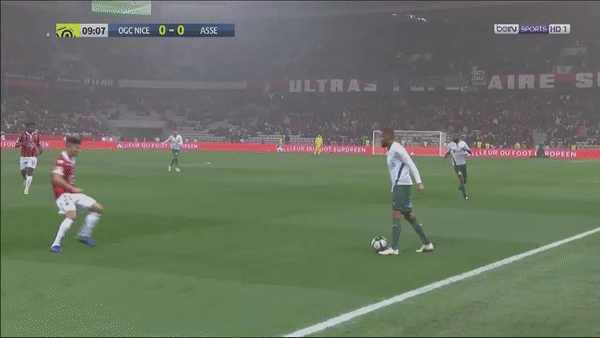
There’s a lot to like with Youcef Atal, especially considering he’s already producing at a high level in his first season in a top five league. His skill set fits with the modern game and the demands put on fullbacks, and his dribbling and high value chance creation go beyond what even most modern fullbacks are capable of as he uses his athleticism in a functional way to create havoc in the final third. It's fair to point out that he's been giving up an exceedingly high volume of turnovers this season, and that puts a strain on the rest of the squad to put out potential fires defensively, but the pluses have outweighed the minuses. His defensive numbers have been elite, albeit there are a couple chinks in the armor when you dive a bit deeper into the film, though there's not much there that's terribly worrying for his future development.
To some extent, it's useful to think of Atal and his optimum utilization like a modern day defenseman in hockey. Like with a defenseman in hockey who wants to bring the puck into the opposition zone, Atal will not hesitate to drive the ball forward into the final third and penalty box. The key is that there's the defensive structure in place to mitigate his high position when a change of play occurs, because that will happen a noticeable amount of times if he plays close to his natural game. If there's not a strategy to mitigate potential transition opportunities, then the balance between what's being put on the table vs what's being taken off isn't as clean. Atal would still remain a net positive, just not necessarily an overpowering one. With all that said, there are several clubs that should investigate Youcef Atal as a long term option, particularly given that Nice aren't a huge club and don't have great odds for attaining European football for 2019-20 so that should make a future transfer fee pretty affordable. Everton would be a smart landing spot, particularly given that Seamus Coleman is 30 years old and his best days are behind him. For a club like Everton who have aspirations of trying to build something more sustainable than what's gone on over the past few seasons and break into the top six, Atal provides them the option of someone who can contribute in the immediate present and for the foreseeable future. If a bigger club within the PL took a similar line of reasoning and wanted both present and future value, than Tottenham could be a logical destination. While Keiran Trippier has his positives, the offense/defense balance has always been a question with him, and he's at the latter end of his prime years as a fullback at age 28. Atal's ceiling is higher than Trippier's present peak, and even his present value is comparable to Trippier's. Within Ligue 1, Lyon would be a good fit as he would compliment the exciting Ferland Mendy as a fullback duo and add another fun player to a squad full of them. Youcef Atal is an exciting fullback and has a diverse range of abilities that you don't see everyday. At the current stage of his career, Atal is tantalizing but has a couple areas of improvement, one being his ability to recognize when and where to gamble with defensive actions. The upside is that with greater maturation to his game (which isn't a guarantee), those areas get ironed out and what you then have is a complete monster who ranks among the elite of the elite in his position and perhaps stretches the boundaries of what the modern day fullback should provide. That upside makes Atal one of the most fascinating young talents in European football, and one that will gain more notoriety as the season goes on.
